

PRISMATIC VISION
Artist Del Kathryn Barton on appreciating the still moments in a kaleidoscopic life and career.


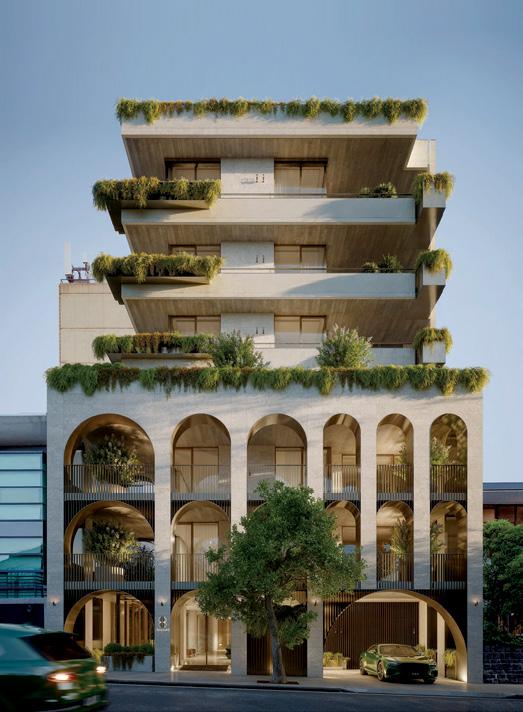

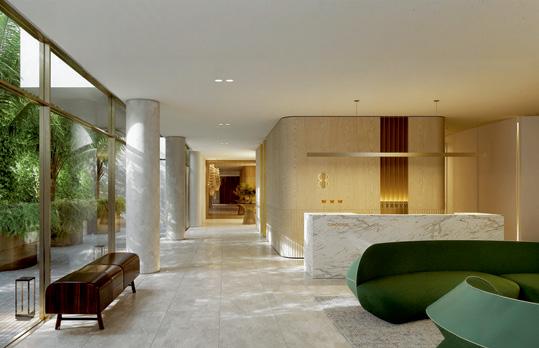
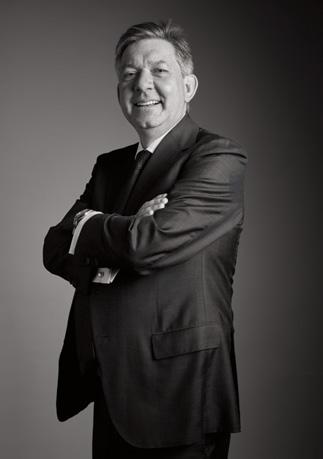
At Kay & Burton, we’re drawn to those moments when potential becomes power and when emerging voices start reshaping the cultural landscape. Issue 11 celebrates these turning points— highlighting the dynamic energy of creatives, brands and business leaders who aren’t just participating in their industries, but redefining the rules with clarity and conviction.
Our cover story features twotime Archibald Prize-winning multidisciplinary artist Del Kathryn Barton (p22), whose boldly imaginative work has captivated audiences globally and positioned her as a defining presence in Australian contemporary art. Barton’s creative vision exemplifies the kind of artistic ascendancy that transcends geographical boundaries and speaks to universal human experiences.
Elsewhere within these pages we explore the meticulous restoration of New York’s Waldorf Astoria hotel (p08), where celebrated French interior designer Pierre-Yves Rochon has revived the icon’s Art Deco heritage; we also visit the landmark Cartier exhibition at London’s V&A (p36), which provides a masterclass in luxury brand evolution; and hear from Melbourne menswear designer Christian Kimber on the evolving rules of dressing (p50). We also showcase some of the rising talent participating in this year’s Rigg Design Prize (p53), and venture to Champagne to discover how the president of one ultra-exclusive house has elevated scarcity into an art form (p17).
As always, The Luxury Report offers insights into the worlds of business, investment and property. In this issue, Michael Saadie draws on findings from NAB’s latest research to explore how small business succession planning is evolving, with new pathways to more flexible and impactful forms of legacy opening up (p13); Sally Auld’s economic outlook (p20) examines Australia’s strong position following recent global trade volatility, identifying key factors driving growing investor confidence; and we sit down with Australian entrepreneur, AirTrunk founder Robin Khuda, to examine the strategic foresight behind his extraordinary business success (p30).
We trust these stories will provide not only inspiration but practical perspectives as you navigate your own professional and creative endeavours. As always, we are eager to hear from you about the ascending stars, remarkable achievements and innovative thinking within your own network.
CONTRIBUTORS
NAB
Michael Saadie
Executive of NAB Private
Wealth & CEO JBWere
Sally Auld
NAB Chief Economist
Mark Browning
Head of Valuations & Property Advisory
Darian Kuzma
Private Client Executive
KAY & BURTON
Ross Savas
Managing Director
Peter Kudelka
Executive Director
Gowan Stubbings
Executive Director
Alex Schiavo
Executive Director
Scott Patterson
Executive Director
Tom Barr Smith
Executive Director
Jamie Mi
Partner & Head of International
EDITORIAL
Common State
Managing Editors
Luke McKinnon
Nick Kenyon
Editor
Leanne Clancey
Proofreader
Cathy Gowdie
Writers
Amelia Barnes
Peter Barrett
Alice Blackwood
Cameron Cooper
Kirsten Craze
Catherine Gillies
Freya Herring
Praachi Raniwala
Anna Snoekstra
Tyson Stelzer
Tomas Telegramma
Lucianne Tonti
Carlie Trotter
Adam Turner
Design and Art Direction
Amber Goedegebuure
Cover Image
Del Kathryn Barton
Photography
Saskia Wilson
Hair and Makeup
Gavin Anesbury
ADVERTISING
Nick Kenyon
Head of Luxury Strategy, Kay & Burton Telephone +61 3 9825 2554 nkenyon@kayburton.com.au
Level 7, 505 Toorak Road, Toorak, VIC 3142
The Luxury Report is published four times a year. Copyright © Kay & Burton. Printed by Neo, 5 Dunlop Road, Mulgrave, VIC 3170. The contents of this document (contents) have been prepared and are provided by Kay & Burton (which means and includes Kay & Burton Pty Ltd, its associated entities and its officers, servants, contractors, employees and agents) in good faith. Some of the contents have been provided to Kay & Burton by others. Kay & Burton does not represent or warrant the accuracy of the contents. The contents are provided solely for information purposes and do not constitute any recommendation, advice or direction by Kay & Burton for anyone to use any of the contents to make any decision about anything and in particular, about making any investment or participating in or acquiring, disposing, selling or purchasing anything or entering into any agreement, arrangement or dealing (whether legally binding or not). Kay & Burton recommends that any such decision should only be made following the receipt of advice from an appropriately qualified advisor.
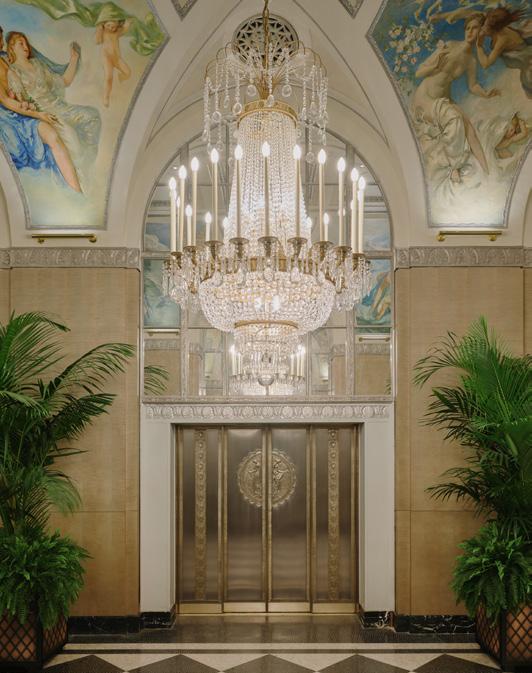

BREAKING FROM TRADITION
Interior designer Pierre-Yves Rochon reveals how he masterfully revived New York’s iconic Waldorf Astoria, balancing careful preservation with elegant restraint.
How British-born menswear designer Christian Kimber is weaving lifestyle considerations into formal suiting conventions to tailor the perfect fit for contemporary Australian men.

STILL MOMENTS IN A KALEIDOSCOPE LIFE
Archibald Prize-winning artist Del Kathryn Barton explores the early influences and deeply personal experiences driving her distinctive creative vision and path to international acclaim.
13 NAVIGATING THE HANDOVER
NAB’s Michael Saadie examines why flexible exit strategies are replacing traditional family business transfers.
17 A MODEST REVOLUTIONARY
Champagne Salon president Didier Depond explains how cultivating rarity has elevated the house to legendary status.
20 STRONGLY POSITIONED
As trade tensions ease, optimistic prospects emerge for well-positioned Australian portfolios.
30 CATCHING THE CURRENT EARLY
How data centre mogul Robin Khuda is now applying his infrastructure genius to craft dream homes.
33 THE NEW LUXURY CEILING
Why $10m-plus sales are now standard and what’s driving Australia’s prestige property evolution.
36 OF CROWNS, STARS & STONES
Step behind the scenes of the exhibition charting how Cartier became the jeweller of kings.
38 THE ETERNAL ENTREPRENEUR
Serial founder Nick Bell discusses his most ambitious project yet: engineering human longevity beyond 100.
41 GROWING CULTURAL CAPITAL
Explore the Melbourne garden project joining a worldwide movement in urban green design.
44 THE SEEKER’S EYE
Discover David Hicks’ 25-year interior design journey and the passionate collecting that fuels his creativity.
53 THE MAKING RENAISSANCE
Meet five rising stars spotlit by Australia’s premier design prize competition.
56 SOPHISTICATED SOUL
Inside chef Tom Sarafian’s debut restaurant where family tradition meets cultural heritage.
58 WHERE SPIRIT TAKES FORM
Trent Jansen on the role of collaboration and cultural immersion in his design practice.
62 OUT AND ABOUT
ornate Silver Corridor at the Waldorf Astoria, New York.
Kathryn Barton at her Paddington studio. Image: Saskia Wilson.
THE SHORTLIST

01 Almas modular sofa system by Knotte
A collaboration between Australian furniture brand Knotte and Melbourne designer Joanne Odisho (recipient of the 2023 Artichoke Emerging Maker Prize), this modular seating system embodies warmth through its generous proportions and signature indented cylindrical bolster backrest.
Named after Odisho’s grandmother, the collection bridges heritage inspiration with modern manufacturing. Crafted in Sydney, the system offers unlimited configuration through straight, curved, corner and ottoman components. Available in premium textiles including Kvadrat’s knitted Uniform Mélange, the system offers both comfort and visual sophistication. POA (subject to configuration). knotte.com.au

02 Atelier Art Deco Limited Edition audio system by Bang & Olufsen
Released to mark the Danish audio pioneer’s 100-year milestone, this home cinema collection reimagines the classic Beovision Theatre soundbar and Beolab 28 speakers with an Art Deco twist. Crafted from rosewood and chestnut-anodised aluminium, each piece features precision-machined geometric patterns with 100 engraved lines commemorating the brand’s centenary. Limited to 100 units worldwide, this fusion of heritage craftsmanship and cutting-edge acoustics elevates audio into collectible art. Available in select stores, POA (subject to configuration). bang-olufsen.com

03 ‘Where have all the flowers gone’ chair by Bieëmele
Conceived last year as a reflection on conflict and its recurring patterns, Melbourne-based maker Scotty Bemelen’s sculptural chair transforms recycled copper water pipes and salvaged timber into a quietly powerful meditation. Inspired by Bernie Boston’s 1967 Flower Power photograph, carved copper blooms emerge from patinated pipes, while the seat layers recycled Oregon, pier and messmate burl timbers with polished beach rock. Named after Pete Seeger’s ballad on history repeating, this handcrafted-to-commission piece feels especially resonant in 2025—a reminder of how design can echo the times while offering comfort. POA bieemele.com
Image: Mark Roper
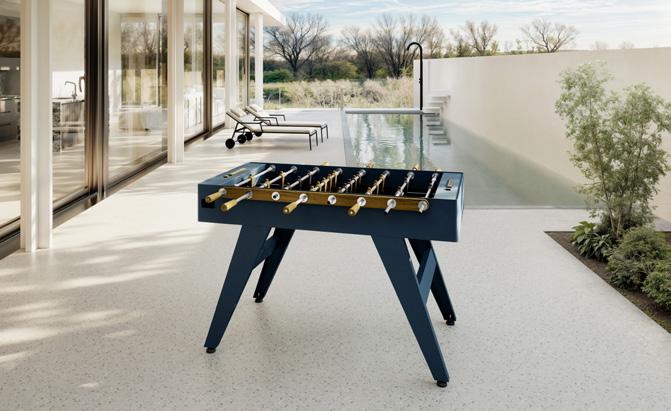
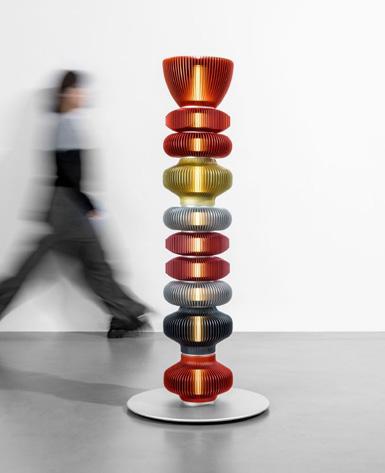
05
04 Boss foosball table by FAS Pendezza
Designed by Milan’s Studio Basaglia Rota Nodari, this regulation-standard table shifts gaming into sophisticated design territory. The Boss combines post-industrial aesthetics with premium functionality, with its sleek black playing field contrasted against durable Iroko wood components. Every element reflects Italian premium gaming specialist FAS Pendezza’s century-spanning expertise. Available in a range of vibrant colours or bespoke finishes, this statement piece will command respect in any space. From $10,600. faspendezza.com
ALLTOTEM sculpture by Michael Young
British industrial designer Michael Young, whose work has been collected by the Louvre, Centre Pompidou and London’s V&A Museum, reimagines traditional Asian lanterns in his ALLTOTEM sculpture series. Where historical paper and silk lanterns symbolise prosperity across Asian festivals, Young’s 18 limited-edition pieces translate these meanings into polished extruded aluminium art objects featuring semi-random patterns. Drawing from his “complex minimalist” philosophy, these towering totems choreograph light and shadow, bridging Eastern cultural heritage with Western manufacturing to create what Young calls “industrial art”. From $22,500. galleryall.com

The
Park Avenue entrance at the Waldorf Astoria, New York.

Listening to legacy
In a city that never stops changing, New York’s restored Waldorf Astoria offers something radical: less intervention, more preservation, and a deep respect for architectural heritage—by Freya Herring.
Few hotels carry the weight of New York legend like the Waldorf Astoria. After a seven-year closure, it has reopened under the passionate guidance of French interior designer Pierre-Yves Rochon—and his passion for the project is unmistakable. “The building itself was the main inspiration,” Rochon says. “It doesn’t need decoration; it speaks on its own. The proportions, the rhythm, the materials, the Art Deco vocabulary—all of that was already present.”
Of course, this isn’t Rochon’s first rodeo—he has been responsible for reimagining many of the world’s great hotels, including Paris’ George V, The Savoy in London and The Peninsula in Shanghai. His history with this particular hotel heavyweight, though, spans decades. “My wife and I stayed at the Waldorf Astoria more than 30 years ago,” he says. “I remember walking through the hotel and saying to her, ‘One day, I would love to redesign this place.’ And years later, the opportunity came.”
The hotel, which dates back to 1893, was demolished in 1929 to make way for the Empire State Building before reopening in its current Park Avenue incarnation in 1931 in a flurry of Art Deco flamboyance. Many illustrious decades followed, with guests from Queen Elizabeth II and Franklin D. Roosevelt to Marilyn Monroe and Frank Sinatra (who also lived there for several years) passing through its bronze-edged doors. By the 2010s the interior had grown tired, and in 2017 the hotel closed for refurbishment. Enter, Rochon.
“My wife and I stayed at the Waldorf Astoria more than 30 years ago. I remember walking through the hotel and saying to her, ‘One day, I would love to redesign this place.’”
“At the time of the renovation, the hotel was closed, of course, but its spirit was still very present,” Rochon notes. “It was a sleeping monument. You could feel the power of its past—the scale, the Art Deco geometry, the energy of New York in the 1930s. What we did was not invent something new; we brought comfort to what was already there. The architecture was already doing its job beautifully.”
The makeover of the Waldorf Astoria has been a labour of love. “The goal was to make it whole again,” Rochon emphasises. “And in a way, more honest— because comfort today is not the same as in the 1930s.” This objective was achieved through careful planning and a profound appreciation for the building’s original form. “This kind of building doesn’t belong to you. It belongs to the city. You’re just a caretaker, really,” he observes. “There was a sense of responsibility in restoring it with care and precision. Our role was not to reinterpret or overdesign—it was to let the building breathe again, and to bring back its original dignity with today’s standards of comfort.”
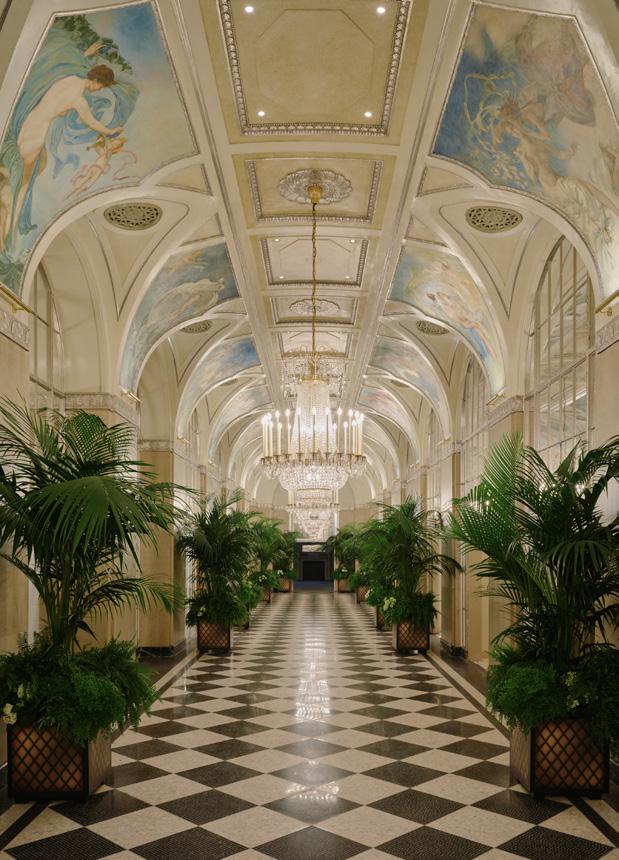
Luxury, through the Rochon lens, is not about decadence or extravagance. “Modern luxury is invisible,” he states. “It’s silence, comfort, discretion. Those things can—and must—be integrated into a historic building, but in a way that never disturbs its essence.” The hotel’s new iteration is a triumph of quiet luxury, with a palette of materials and tones that highlight and celebrate its 1930s heritage.
“The clock in the lobby remains exactly as it was,” notes Rochon. “There are also the main doors, the historic entrances, the mosaics in the floor—these elements are part of the collective memory. We didn’t need to reinvent them. We needed to care for them.” This meticulous care is evident in details like the lobby clock restoration, on which a team

01 The hotel’s fresco-lined Silver Corridor.
02 Cole Porter’s vintage Steinway piano takes centre stage in the glamorous Peacock Bar, set within the hotel’s soaring grand atrium.
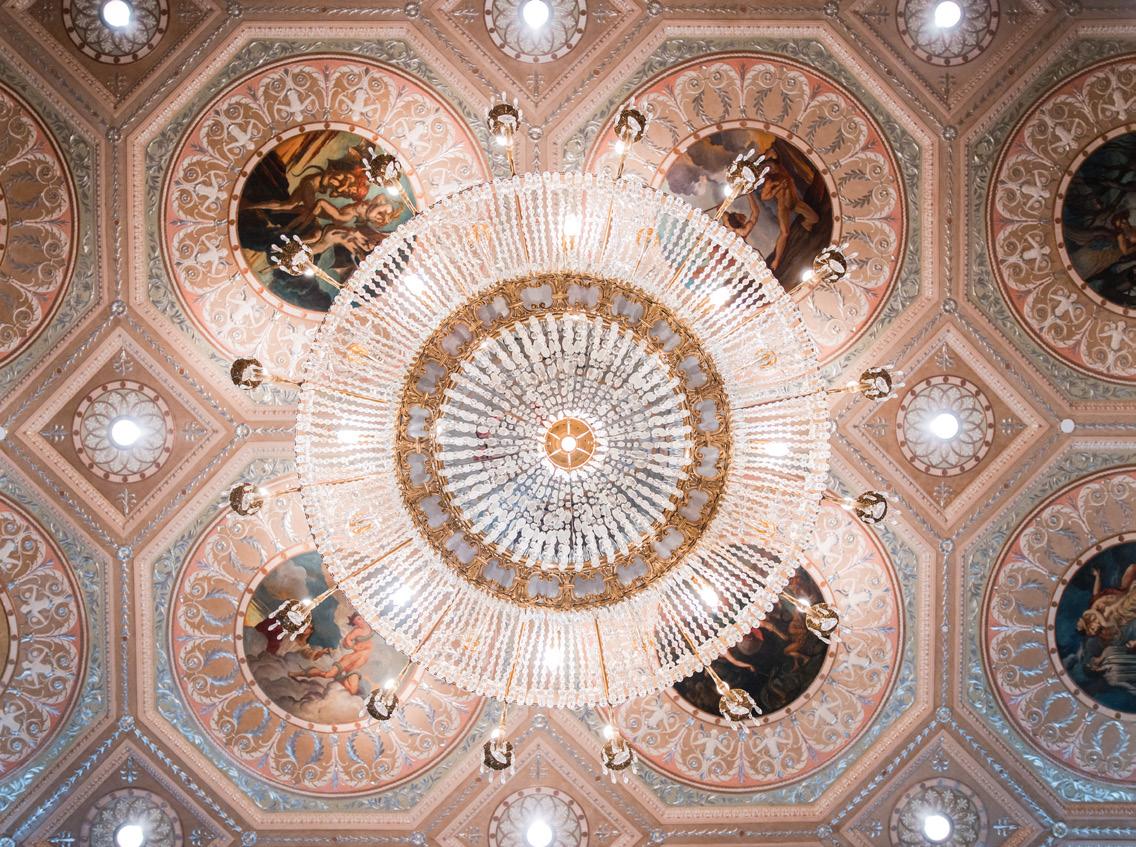
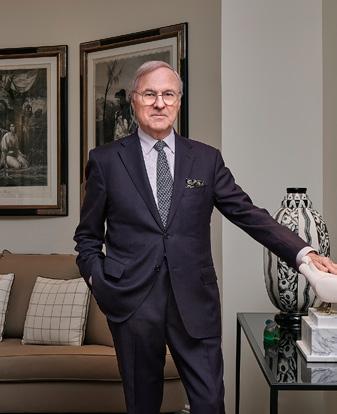
comprising a master metalsmith, clockmaker and four conservators worked for almost a year, painstakingly restoring each component.
“We worked with preservation teams, with artisans, and above all, with the [hotel’s] history,” Rochon explains. “Every time we touched something, we asked, ‘Can we conserve it? Can we repair it? And if we must replace, how do we do it respectfully?’” The process was laborious, but for a building with such significance, it was also a vital endeavour. “There were many challenges, but we took the time. You don’t rush a building like this,” he maintains. “It’s like restoring a piece of music—every note matters.”
Sweeping changes converted the hotel from 1400 guest rooms to 375, with the smallest room measuring
twice the size of the hotel’s original rooms. There are also 372 privately owned condominium residences designed by Jean-Louis Deniot on the upper floors. “Many of the structural elements couldn’t be touched. We had to respect the historic envelope, while also introducing entirely new functions and layouts,” Rochon explains. “On the Park Avenue side, for instance, there were split levels and odd transitions that made orientation difficult. We had to find a new spatial logic within a protected shell. Another challenge was daylight, or the lack of it, in certain areas.” In response, a mezzanine was removed to bring back natural light that had been lost for decades, an entirely new lobby was created, and the ground floor sequence was reordered. “It’s not just about aesthetics,” insists
03 Anchored by an ornate central chandelier, the restored ceiling of the Basildon Room features 24 paintings inspired by Dante’s Divine Comedy
04 French interior designer Pierre-Yves Rochon.
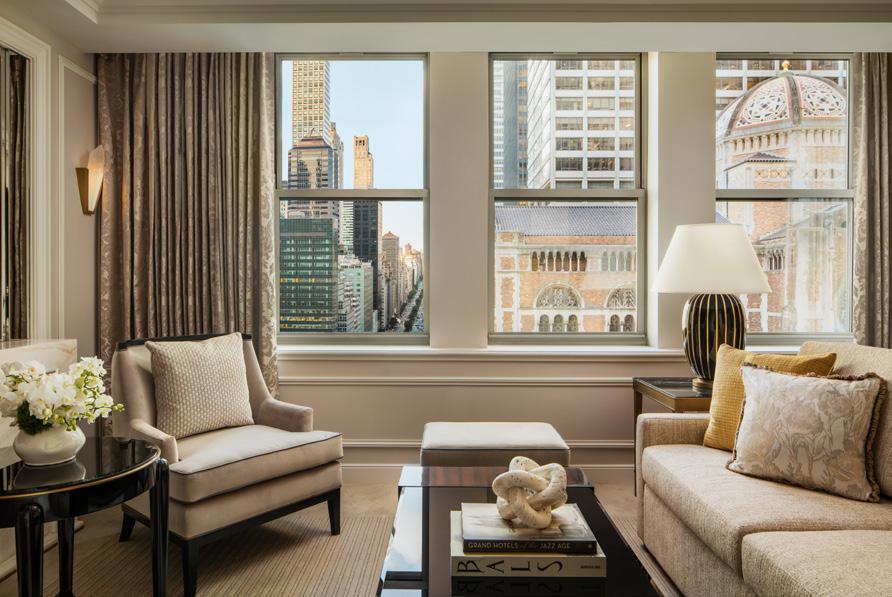
Rochon, “it’s about restoring logic and clarity to the flow of the space.”
The sense of clarity extends into the hotel’s colour palette, which is often pared-back and almost celestially pale. In a relentlessly loud and hectic city like New York, it’s an approach that feels like a welcome tonic to the fray. The bedrooms encapsulate this—soft, tactile fabrics that both soothe the spirit and muffle the noise, a prominence of cream and white tones, and decor that is both minimal and considered. As with much of Rochon’s oeuvre, there is the sense, if not the reality, of diamonds— glittery moments flickering in the light. Like a diamond’s cut, the design appears simple from a distance but upon closer inspection reveals the rich detail and craftsmanship it took to shape it.
The hotel’s Silver Corridor and Grand Ballroom have been restored to their magnificent states, but the newly reinstated Peacock Alley offers a moody contrast—dark and richly textured with maple burl wood
panelling, blue carpets and ornate ceilings. Stretching from Park to Lexington Avenue, it is named after the fabled corridor which linked the former Waldorf and Astoria hotels after they merged in 1897. Back then, patrons would promenade between the buildings, ‘peacocking’ the latest fashions and establishing themselves as New York’s most fashionable set in doing so.
Its new manifestation honours the original by reintroducing materials from the initial designs, such as Portoro marble. “It’s a rich black marble with golden veins, typical of the 1930s,” Rochon says. “It gives a sense of rooted elegance.” Facets that couldn’t be saved were sympathetically replaced. “We couldn’t save the original carpet in Peacock Alley,” he explains. “We created a new carpet as a reinterpretation, drawing from archival motifs.”
Historic pieces take pride of place: a clock commissioned by Queen Victoria in 1893, and the
grand piano gifted by Cole Porter, who lived at the hotel for some three decades. Bronze accents, too, were brought back. “Always with a patina; never shiny,” notes Rochon. “This project was less about introducing new materials than about restoring existing ones. The soul of the Waldorf Astoria was already there, we just helped it re-emerge.”
Rochon hopes that this approach could mark a way forward for future grand hotel renovation. “We don’t need to constantly invent,” he says. “Sometimes, the most powerful gesture is to listen to the building, to trust its original language, and bring it into the present with precision. That kind of integrity, I think it’s what guests are looking for now. Not noise, not novelty—but truth.”
05 Living room space of guest suite with Park Avenue view.
The Waldorf Astoria will make its Australian debut in Sydney in late 2026.
NAVIGATING THE HANDOVER

As nearly half of small business owners approach their final decade at the helm, Australia is bracing for a historic transfer of ownership that will test succession plans and family readiness—writes Michael Saadie, executive of NAB Private Wealth and CEO JBWere.
Across the business landscape, an evolution has begun. The traditional dream of building a business to pass down through generations is dissolving and being replaced by something more complex. Our latest research report, conducted with market intelligence firm CoreData, reveals that only 39 per cent of small business owners expect their children to take the reins—a seismic shift from the succession ambitions that once defined business ownership.
This is not merely statistically significant. With small businesses (defined as those employing fewer than 20 people) accounting for a third of national GDP and employing over 5.3 million people, we are witnessing a reimagining of how wealth, purpose and legacy intersect in modern life. The implications go beyond balance sheets into how we define and conceive success, retirement and family prosperity.
BECOMING UNANCHORED
Within the wealth management sector, conversations are evolving. Where we once discussed tax structures and asset allocation, we now find ourselves grappling with questions of identity, purpose and fulfilment.
One client recently described selling their business to a US private equity firm as “like winning the lottery”, but that excitement was overshadowed by disorientation and a peculiar sense of mourning. After two decades building a 12-person operation into a thriving global enterprise with more than 120 employees, they found themselves
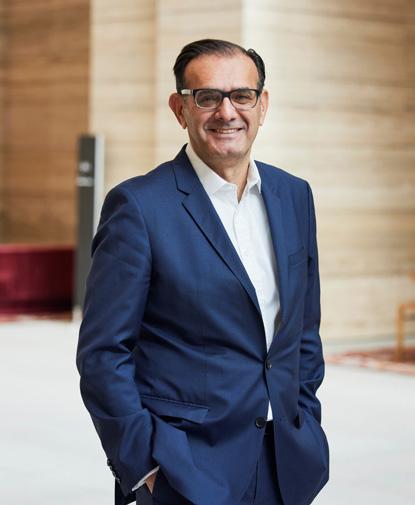
untethered. The business was not just their wealth creator, it was their daily driver and social ecosystem. While these discussions consume our advisory sessions, the policy response remains behind the curve.
The numbers tell a sobering story: nearly half of Australian small business proprietors are aged over 50, with 22 per cent just five years from pension age. Even so, only 34 per cent have a documented succession plan. Another 31 per cent have discussed plans without formalising them, while 20 per cent keep their intentions entirely to themselves. This is not procrastination—it is paralysis in the face of fundamental questions that numbers alone cannot answer.
THE PULL OF DIFFERENT TIDES
Why are the children of successful businesspeople increasingly stepping away from the family business? The answer lies partly in the vast range of alternatives that beckon from every corner of our evolving economy. The tech sector’s appeal, with its promise of scale, offers emerging talent the chance to build billion-dollar valuations without the decades of hands-on management that their parents endured.
With young professionals drawn to inner-city innovation hubs, the industrial and regional areas where many family enterprises operate feel increasingly remote, geographically and culturally. The inherited logistics company in the suburbs, however successful, struggles to compete with the allure of a CBD startup or global consulting firm.
We are also witnessing a generational shift in how success is defined. Where their parents measured achievement and success in revenue growth and market share, millennials and gen Z prioritise flexibility, purpose and impact. The prospect of inheriting the family firm can be less appealing than launching a sustainable fashion brand or joining a climate tech venture, for instance.
HALF-SPEED AHEAD
Traditional retirement—that significant moment when one stops working entirely—is becoming as outdated as the farewell morning tea. Our research reveals that 54 per cent of small business leaders plan to be partially retired but working by choice at 67, with another 29 per cent expecting to work full-time by choice. This is not driven by financial necessity, but by something more fundamental.
I call this ‘punctuated retirement’: a deliberate, flexible transition that maintains intellectual and social engagement while shedding the management burden. It is about preserving what energises while removing what exhausts. Most of the survey participants cite intellectual stimulation as their primary motivation, with enjoyment and purpose close behind.
This shift demands sophisticated wealth strategies. At NAB Private Wealth, we are seeing clients design complex structures that allow them to retain strategic involvement while delegating day-to-day control. They are building portfolios of non-executive directorships or channelling their expertise into philanthropic initiatives.
SPREADING THE SAILS
Perhaps no challenge is as acute as the ‘empire mindset’ that keeps wealth dangerously concentrated. Business owners naturally gravitate toward what they know, often maintaining most of the family wealth within their company. It is familiar, it is controllable, and it has worked so far. The burden of being solely responsible for revenue has also made many afraid to look beyond the business. But this concentration creates its own challenges.
The adviser’s role has transformed from simply recommending diversification to becoming a translator between the familiar and unfamiliar. We must explain how a diversified portfolio spanning public markets, property and alternative investments provides not only risk mitigation but also the liquidity needed when the next generation requires capital for their own enterprises or property purchases. This is particularly critical given that over half of businesses with revenues exceeding $200,000 hold commercial property or high-value assets, often illiquid and difficult to partition among beneficiaries.
Michael Saadie, Executive, NAB Private Wealth and CEO, JBWere.
CHARTING THE COURSE
The key is starting important succession conversations years or even decades before handover. When company structures are properly established from inception—with clear separation between personal and business assets, appropriate trusts and tax-efficient vehicles—the eventual transfer becomes more seamless and less complex.
Family discussions should begin early, allowing friction points to surface and resolve well before any transfer of leadership or the commencement of sale negotiations. Through our private banking network and JBWere’s family advisory services, we facilitate these often sensitive discussions in confidential settings where discretion is paramount. We also host networking events which bring together business owners facing similar transitions, creating safe spaces for sharing experiences and strategies.
With a quarter of businesses set to close upon their owners’ retirement, we are witnessing the end of automatic succession and the beginning of something deliberate and meaningful. Modern legacy surpasses company continuity, extending to embrace philanthropic endeavours, impact investing and social enterprise.
This legacy planning process begins with essential questions: What is the purpose of this wealth? What world do we want for future generations? Once families answer these questions, many discover new paths forward. We observe founders channelling their entrepreneurial energy into venture philanthropy and multigenerational foundations to create new forms of family unity without shared business operations.
Employee buyouts are among the solutions now emerging, allowing executives to reward loyal teams while ensuring business succession. These structures preserve local employment and community engagement while freeing founders to pursue new challenges. It is inheritance reimagined, enabling future prosperity rather than dictating its terms.
PREPARING FOR THE WAVE
Looking ahead, we face an unprecedented wave of ownership transfers. With the number of small businesses having doubled over the past 25 years to 2.6 million, and baby boomers approaching retirement en masse, we need robust infrastructure to facilitate smooth succession.
This requires creating frameworks that support emotional, financial and practical transitions simultaneously.
The current reality, where only 30 per cent of small business owners maintain ongoing relationships with financial advisers, suggests many people are incredibly underprepared. The complexity of 21st-century succession demands coordination across private banking, wealth advisory, tax planning and family counselling. NAB Private Wealth brings together business bankers, private bankers and wealth advisers from the very beginning. This collaborative, end-to-end approach, supported by JBWere’s investment advisory, nabtrade’s self-directed platform and NAB Ventures’ innovation ecosystem, helps ensure seamless support across business, financial and personal planning.
We also recognise that women will be among the largest beneficiaries of the upcoming wealth transfer. This drives our continued investment in female advisers, who are a critical part of our team and well placed to serve this demographic.
CATCHING NEW WINDS
In working with and supporting entrepreneurs, I have observed that many find their post-exit ventures more fulfilling than their original businesses. Freed from daily pressures and armed with capital and experience, they are funding innovation, backing tomorrow’s leaders and pursuing meaningful causes with characteristic determination.
Rather than viewing the move away from traditional succession as a negative trend, we see important progress toward increasingly flexible and impactful forms of legacy. For those willing to plan early, diversify thoughtfully and reimagine retirement, this transition represents not an ending but a beginning.
Our thoughts around succession are changing because the world is changing. The question is not whether to adapt but how quickly and thoughtfully we can build new models that honour both achievement and aspiration, serving not just the generation that built wealth, but also those who will build differently.
In this great unbundling of business and family, opportunities abound.
Read the full Beyond the Business: Navigating Retirement and Succession for Small Business Owners report at business.nab.com.au/life-beyond-your-small-business.
This article has been prepared by National Australia Bank Limited ABN 12 004 044 937 AFSL and Australian Credit Licence 230686 (NAB). The information contained in this article is believed to be reliable as at September 2025 and is intended to be of a general nature only. It has been prepared without taking into account any person’s objectives, financial situation or needs. Before acting on this information, NAB recommends that you consider whether it is appropriate for your circumstances. NAB recommends that you seek independent legal, property, financial and taxation advice before acting on any information in this article. All products and services mentioned in this document are issued by National Australia Bank Limited ABN 12 004 044 937, Australian Credit Licence and AFSL No. 230686 (NAB), except wealth advice services, which are provided by JBWere Limited ABN 68 137 978 360 AFSL No. 341162 (JBWere), and nabtrade, which is the information, trading and settlement service provided by WealthHub Securities Limited ABN 83 089 718 249 AFSL No. 230704 (WealthHub). WealthHub and JBWere are wholly owned subsidiaries of National Australia Bank Limited (NAB). WealthHub’s and JBWere’s obligations do not represent deposits or other liabilities of NAB. NAB does not guarantee its subsidiaries’ obligations or performance, or



A modest revolutionary
Under Didier Depond’s quiet stewardship, Salon has become champagne’s holy grail; a small luxury brand that punches far above its weight in the shadow of its seven-millionbottle parent company. Here, the man behind the mystique explains how humility built an empire—by Tyson Stelzer.
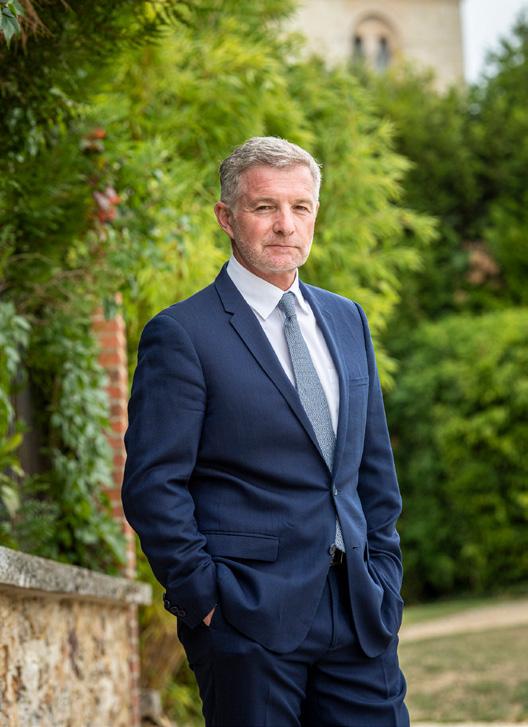
When Didier Depond was first offered the presidency of Champagne Salon over the phone nearly three decades ago, his first response was to ask his boss if he was drunk. All these years later, he oversees some of Champagne’s most exclusive and expensive bottles—fewer than 50,000 per vintage, each one coveted by collectors across the globe.
The year was 1997, and 33-year-old Depond was on assignment hosting a tasting abroad, having spent 11 years working his way up from a salesman to marketing director of Champagne Laurent-Perrier. The late Bernard de Nonancourt, then-owner of Laurent-Perrier, was on the line from Italy offering Depond the role.
Within a week, Depond was back in the home of this fabled house in the Champagne grand cru village of Le Mesnil-sur-Oger, assuming responsibility as president of Salon Delamotte. The role would have him oversee both houses: the ultra-rare Salon, which releases vintages only in exceptional years, and Delamotte, the more accessible champagne house founded in 1760. Under Depond’s guidance over the past 28 years, Salon has risen to become one of the most sought-after champagnes globally, with the street price effectively tripling in less than a decade. But it wasn’t always this way.
“Thirty years ago, Salon Delamotte was not what it is today,” Depond recalls. “It was a little bit difficult, following ownership by Pernod Ricard, so it was not very famous and did not have a good image. I slowly started to rebuild the houses.”
It’s no simple calling to manage a small luxury brand under the broad umbrella of a large owner. Laurent-Perrier

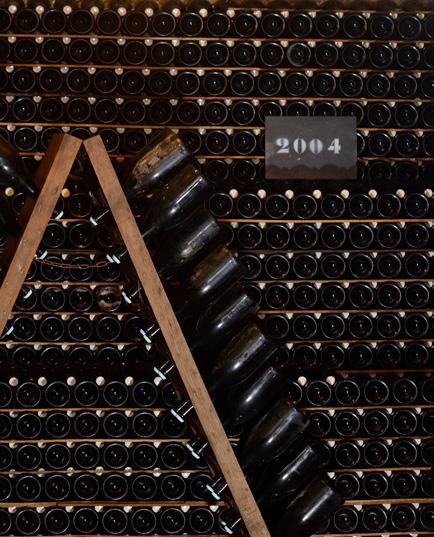

produces close to seven million bottles annually, while the recent release of fewer than 50,000 bottles of Salon 2015 represents just the 45th vintage since 1905.
“There are some examples of luxury products where they are no longer the same volume and no longer the same quality. But for the past 28 years, I have never, never, never increased the volume,” Depond emphasises. This is no small feat for a brand for which he estimates demand outstrips production 100-fold.
“It was very simple with Bernard [de Nonancourt]—no big strategy or crazy ideas. The only point that he emphasised repeatedly was, ‘You have time to do the best.’ Money was never a problem, and he always told me to take my time. ‘If you decide it is not the right vintage for Salon, it is your decision,’” the Laurent-Perrier veteran had told Depond.
It was this freedom that gave Depond the confidence to take on the role, despite his youth at the time. “I remain extremely free,” he explains. “And if this were not the case, I would not be in the company any longer.”
While giving Depond the autonomy to define his own role, de Nonancourt’s mentorship proved formative. “He was like my second father,” Depond reflects today, “an incredible man, a master, a direction to follow. He was close to two metres in stature, like a mountain, a rock. And he was super kind, super sweet and super strong. He was a role model for
05 The gates of Salon House, in France’s Côte des Blancs. Image: Leif Carlsson.
01 In its quest for perfection, Champagne Salon produces an average of just three to four vintages per decade.
02 Didier Depond, president of Champagne Salon and its sister house Champagne Delamotte. Image: Leif Carlsson.
03 Champagne Salon’s Blanc de Blancs style uses chardonnay grapes sourced exclusively from the grand cru village of Le Mesnil-sur-Oger.
04 Wine critics consider the 2004 Champagne Salon among the greatest vintages of the past two decades.
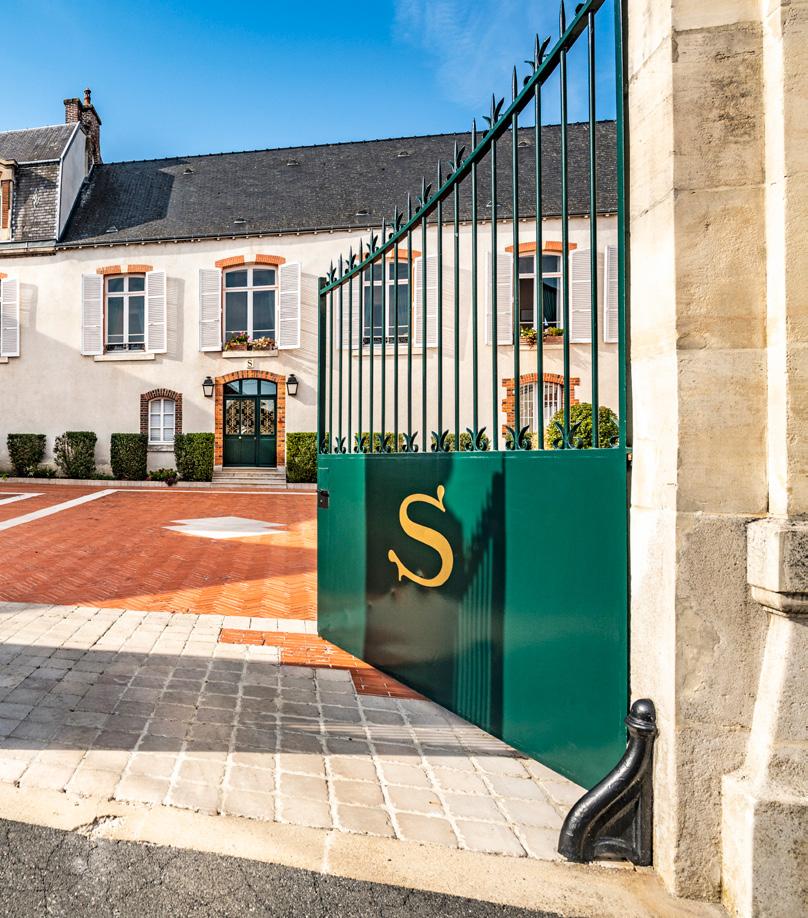
me. I am small and I am not very intelligent, so I tried to follow him,” he laughs.
Depond, of course, is much smarter than he admits, and is due credit also for the rise of Salon’s sister house, Delamotte. “The two houses are like my right and left hands, my balance,” he says. “Salon is the superstar, but like my two children with two different characters, I love Delamotte [equally].”
When Depond took the helm, Delamotte produced just 200,000 bottles annually, mushrooming to one million today. In an era when it is popular for champagne houses to increase the diversity of their offerings, Depond courageously bucked the trend by streamlining the Delamotte portfolio to just five cuvées. “This has not been a problem for us,” he reveals, “because when the market is difficult, it needs something that is clear.”
Meanwhile, Salon continues its dizzying upward spiral. “Thirty years ago, it was all about the bubbles,” Depond says, “and now champagne is seen as a great wine with bubbles, with perhaps even greater potential for ageing than other wines.” The transformation extends beyond perception to market dynamics. “We drink champagnes at 50, 70 or 90 years of age and they are still perfect. When I started [working] in Champagne 40 years ago, champagne was never in auctions.”
The turning point came roughly five years ago when an investment article appeared focusing on blue-chip wines like Domaine de la Romanée-Conti and Petrus. “At the end of the article, it said, ‘If you want to make money fast, invest in Salon, because it is under the radar,’” Depond recalls. “After this article, the demand increased dramatically.” While he now works with auction houses, Depond maintains perspective: “This is not the priority for me. Auctions are good for the image, but not for day-to-day business.”
For all he has achieved in his tenure, Depond remains unassumingly reflective. “My legacy at Salon and Delamotte, and in my personal life, is that I want to be the most discreet for those coming after me. I am not pretentious enough to believe I must leave something. I have spent 28 years at Salon Delamotte, and maybe I will have five or 10 years more, and I will continue to work like this... and the next person will do it differently.”
It’s a mindset rooted in accepting constant change. “The last 30 years were different from how the next years, months and weeks will be,” he notes. “So, my focus is not on my legacy—what happens in 10 years is not important to me. Tomorrow is important, the next harvest is important. We will be very disappointed if we focus on 20 years. We need to be much more focused on the reality of the present.”
STRONGLY POSITIONED
As global trade war fears subside, Australian investors are primed for their next strategic moves in a brightening market, writes NAB chief economist Sally Auld.
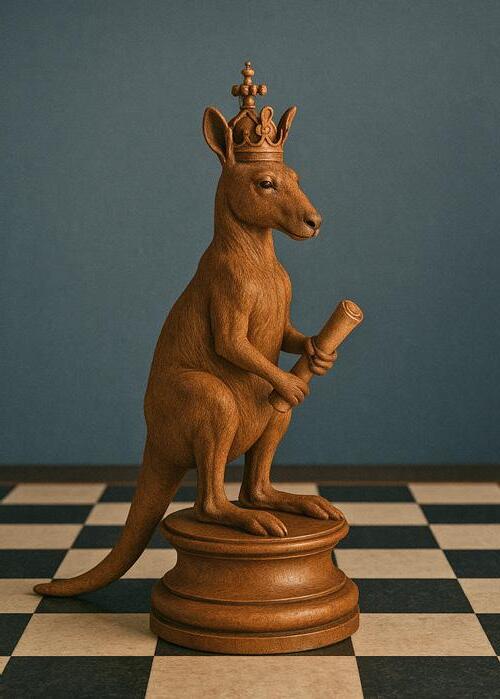
Two years of economic uncertainty are finally giving way to measured optimism. With minimal impact to date from the Trump administration’s tariffs and global market volatility easing, Australia’s economy appears poised for modest growth in the next 12 months. High net worth Australians have, for the most part, weathered the storm well over the past two years as low debt levels and high interest rates have worked in their favour. This cohort has helped sustain Australia’s consumption levels, and now, on the back of rising market confidence and strong asset prices, there is seemingly little to stop the spending of these hard-earned dollars in 2026.
The July 2025 NAB Monthly Business Survey also pointed to companies feeling slightly more optimistic about the future, adding to hopes of a positive shift in Australia’s macroeconomic trajectory. We expect GDP growth to return to trend during 2026, while unemployment is forecast to rise only modestly, peaking at 4.4% by the end of 2025. Inflation, meanwhile, is looking likely to settle at about 2.5%, aligning with the mid-point of the Reserve Bank of Australia’s target range. However, the RBA remains cautious. NAB is predicting two more rate cuts by February next year, bringing the cash rate to 3.1%. There is also optimism that Australia’s reliance on government spending will lessen, with an invigorated private sector leading a new growth phase.
NAVIGATING GLOBAL HEADWINDS
While Australia remains sensitive to external developments, the economy seems to be turning the corner. Earlier this year, markets were fretting about the impact of the Trump tariffs and global trade disruption. While the long-term implications of American trade policies remain unclear, the US economy continues to tick along, and concerns about a full-blown trade war are diminishing.
Australia is well placed to weather any international volatility. We have largely avoided punitive US tariffs, inflation is under control, and the RBA has the capacity to cut interest rates as a stimulus measure if it so chooses. In short, the worst seems to be behind Australia, and there are some encouraging dynamics for the economy as it enters the second half of the year. As high-income households continue to increase discretionary spending and weigh up smart investments, there is a growing sense of optimism.
REVIEWING PORTFOLIO STRATEGIES
With conditions stabilising, asset allocation is again the focus for sophisticated investors. Equity markets, including the S&P 500, have enjoyed an extraordinary run, and key stock exchanges are sitting on or near record highs. As a result, the risk-reward equation for investors has shifted, and it may not be the right time to go hard on equities.
Our colleagues at JBWere are advocating for more defensively positioned portfolios, adding that fixed income generally offers attractive risk-adjusted returns. While pockets of value remain in equities, especially in healthcare and energy, there is a risk of being overweight in this asset class, and any new equity exposure requires careful consideration.
This applies to offshore allocations too, with JBWere cautioning against rushing into US-dollar assets after a decade or more of equities outperformance. Bringing capital home or targeting underweight options such as Japan, Europe or emerging markets may deliver better value. For instance, Southeast Asia continues to appeal, with strong demographic trends and favourable fundamentals creating long-term investment potential.
THE AI ‘ARMS RACE’
The latest data from global technology company Capgemini shows that the total wealth among Australian high net worth individuals rose 3.3% in 2024. With more money at their disposal, investors may increasingly consider opportunities in the artificial intelligence
space—a theme that is dominating capital markets.
Some AI front-runners are engaged in aggressive capital expenditure across R&D and business development, in contrast to a few years ago when companies prioritised lean operations to generate healthy cash flow. This new AI ‘arms race’ has created an environment that is ripe with opportunity, but not without risk. The burden of proof is on firms to demonstrate to investors that the vast sums of money being spent are likely to yield decent returns.
History tells us that only a few winners emerge from periods of aggressive expansion, with the rest often struggling to compete. During the next 18 months, these AI and technology companies will need to validate their strategies through strong financial performance.
HIGH-END PROPERTY IN FAVOUR
There has been a clear upswing in luxury property sentiment on the back of sustained house price growth and recent RBA rate cuts. New records for property sales around Australia, including existing dwellings and yet-tobe-built penthouse apartments in Sydney and Melbourne, highlight the confidence in the luxury property market.
Top earners appear to be allocating more capital to prestige real estate, viewing the asset class as a long-term wealth builder and a hedge against inflation. Such interest is being reinforced by likely changes to superannuation tax rules. The Australian Government’s move to lift taxes on super balances exceeding $3m is prompting some individuals to diversify wealth outside traditional retirement accounts, with premium property emerging as a preferred option. The segment is proving resilient, with declining borrowing costs and strong foreign capital inflows expected to support ongoing strength in high-end real estate markets.
TEMPERED EXPECTATIONS
While much of the hysteria around US trade policy has started to die down, it is worth acknowledging that economies and investors are experiencing historically unusual events. With this in mind, we do need to keep an eye on markets and any left-field developments, or what we economists like to call ‘non-linear effects.’
US fiscal conditions remain concerning and have the potential to unsettle global markets, and we do seem to be living and investing in a world that is less stable and more fractious than in the past. Amid brightening domestic conditions, there is still a need for vigilance and for investors, the importance of diversification, flexibility and robust risk management may be greater than ever.
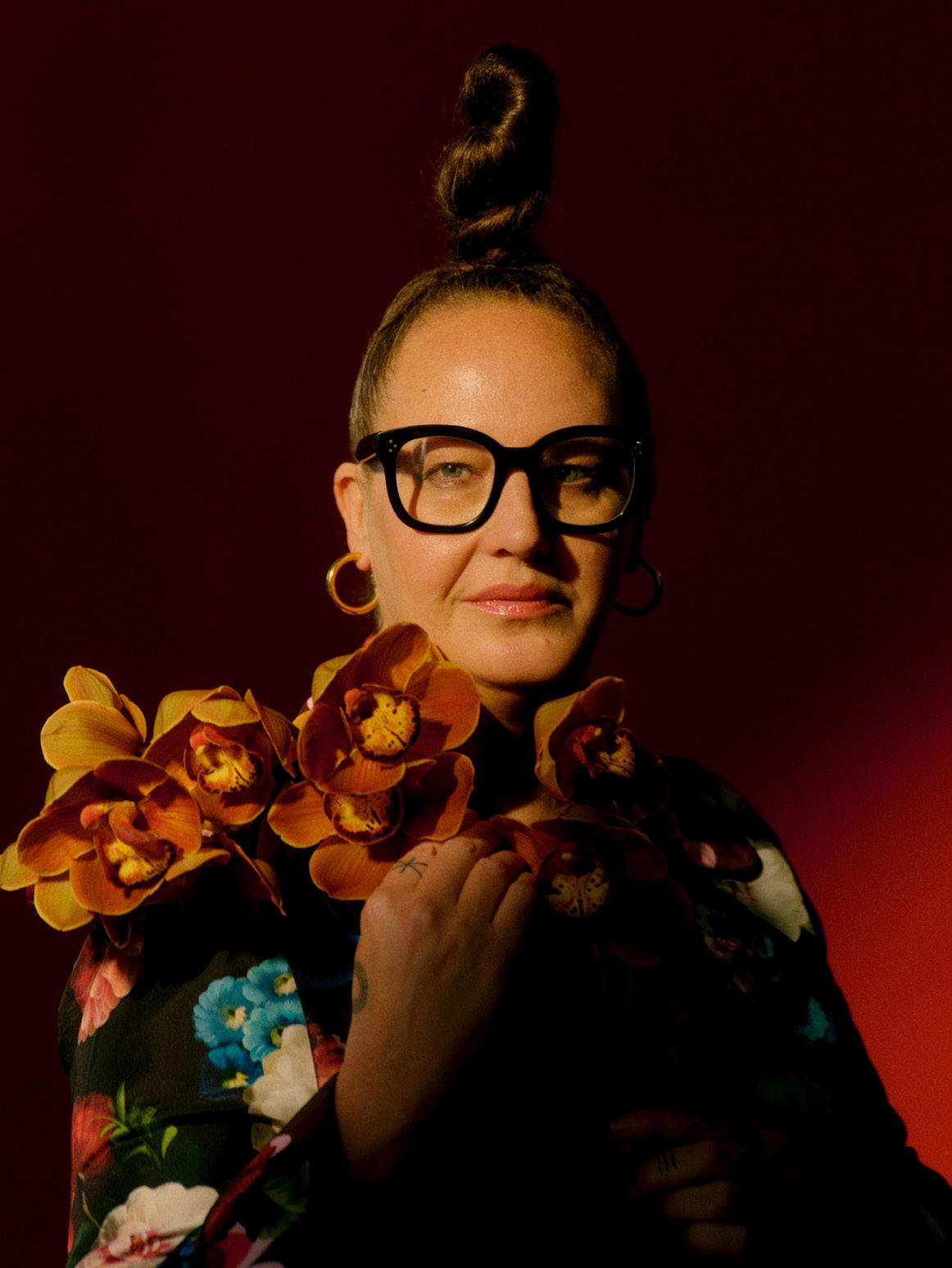
STILL MOMENTS IN A KALEIDOSCOPE LIFE

Known for her maximalist and hyper-detailed artworks, Del Kathryn Barton joins the dots of her evolution into one of Australia’s top contemporary artists—by Anna Snoekstra.
Del Kathryn Barton is tired, but that won’t stop her.
She speaks to me from her Paddington studio, in Sydney’s leafy inner-east, her hair piled high and her outfit a magic eye of layered patterns. The space around Barton is overflowing with colour, paint splatter and empty easels. The huge paintings, drawings and sculptures themselves are gone.
The day before, she had shipped an exhibition of new work to Korea, for her outing at Frieze Seoul with Melbourne’s Station Gallery—a deadline that came within a week of sending off work for a return show at Albertz Benda in New York titled the more than human world
I’m instantly curious about the way she titles her works, always in lower case and often expansive. Barton tells me she chooses lower case because, in her words, “I want there to be a sense that there’s no real beginning and no real end. [The titles are] these poetic bubbles of text floating around the practice that can offer moments of potential connection or interpretation without it being fixed.” She resists the pressure on artists to offer direct explanations of their art, but offers: “The essence of my work, the female protagonists
and the worlds that they inhabit are very heightened. There’s a strong sense of humanity, but it goes beyond the everyday.”
I ask Barton if she’s planning to take a break to recover after these big milestones, especially with a new book of her work being released with Station in coming weeks, but she gives me one of her signature explosive laughs. She’s just signed on for another show in Miami. For Barton, her art practice isn’t something she wants or needs a break from— it’s what gives her energy. “I’m not an artist who ever has creative blocks,” she explains. “If anything, there are just too many ideas and the constant desire to make. It’s about the challenge of grounding that [impulse] and not feeling overwhelmed. My brain and my sensory experience of being human are very, very fertile.”
Digging deeper into her practice, she says: “This fertile quality and my maximalist aesthetic, and experience of inhabiting a female form, is all very layered and dense and complex. I think, for me, bringing that down to a single image is enormously challenging, but it gives me a lot of calm as well,” she explains. “I love to think about
01 Del Kathryn Barton’s unique vision has transcended Australian boundaries to capture global attention. Image: Saskia Wilson.
02 Still from Barton’s film, The Nightingale and the Rose, 2015. Image: Aquarius Films.

the paintings as being like the centre of a spider web; a distilled moment that lots of different narrative and sensory experiences extend from.”
We discuss this idea of distilled moments from which so much colour and story can expand, and I ask Barton if she can think of any such moments from her own life: moments that have transformed her as a woman and an artist. “I’m 52 now,” she says, “so you can look back, and you can join the dots, you know, to find coherence. Living it is just the big, messy experience of being human every day.”
“Living it is just the big, messy experience of being human every day.”
The first moments that began her practice were incredibly difficult ones. As a child, Barton lived with her parents and two siblings in tents on a huge 20ha property in the lower Blue Mountains, surrounded by 200ha of forest. She experienced debilitating episodes of auditory and visual hallucinations. Her mother, a committed Christian and Steiner school teacher, went to a series of alternative healers to help her daughter. “No one really knew what was happening. My mother, in the end, when I was having an episode, just encouraged me to draw in those moments.” Barton would feel disembodied during these episodes, but the act of drawing helped her become present. “It was a way of coming into my body and feeling safe, and just getting the energy moving through, and distracting the fear place of the mind with the act of creating something. That’s a life-giving space; a regenerative space; a space of joy and possibility. I use my practice in that way to this day, even though it’s a professional studio. I have staff, I have deadlines, blah, blah, blah. Still, it’s the life-giving force that drives my concerns.”
I ask her how this experience connected to the next significant moment of her creative evolution: art school. She admits the contrast was tough. “I left home when I was 17,” she says. “I was very innocent. I wasn’t streetwise at all. And I moved to [Sydney’s] Newtown, the inner city.” While the program exposed her to groundbreaking artists she deeply admired—including Joy Hester, Louise Bourgeois, Jenny Watson and Sally Gabori—the institution’s conceptual emphasis clashed with her more intuitive, process-driven artistic nature. Beyond providing her with a framework for understanding her work’s place within the contemporary canon, art school’s most valuable lesson was profoundly personal. Barton discovered what she fundamentally needs for her practice: “A private space, a sense of sanctuary, a space where my body feels very safe. Where I can feel whatever I need to feel, because I have a lot of big emotions that I manage every day.” This revelation about the necessity of emotional and physical sanctuary became, as she puts it, “the biggest takeaway from art school.”
The next turning point arrived when she was hanging drawings for a group show at Sydney’s College of Fine Arts, and the late legendary Sydney art dealer Ray Hughes walked in. Barton’s graphite drawings were emotional self-portraits, some quite graphic. Hughes bought one that night, and from there became her mentor. He understood who she was as an artist, and who she could be if she focused on figurative practice centring on lived experience. She credits his support with “changing everything,” transitioning her from studio practice to professional practice.
At this point in her career, Barton’s art was monochromatic and focused on drawing, but that changed with the birth of her son. “Our first pregnancy was unplanned. I was catapulted into the experience of a pregnant body, which I absolutely loved,” she enthuses. “The birth was long and protracted, but it was the birth I wanted, and that was incredibly meaningful to me. It was a whole different way of being in my body as a woman; it was so abject but so glorious.” Barton can vividly remember seeing her son, Kell, for the first time. “He’s got these amazing green eyes, and I had never felt more—bless my partner, I love him and we’re still together—but I had never felt more dizzyingly in love in my whole life. It’s a love that you don’t have to be afraid of, that’s just so pure, and the reciprocity is so deep, and the alchemy is so deep.” Barton returned quickly to her studio after recovering from the birth and began painting again, using colour for the first time in her professional life. “Look at my paintings now, [they’re like] rainbow kaleidoscopes. Kell was the beginning and the end of the rainbow for me all at once.”
The birth of her son was followed two years later by the arrival of her daughter, Arella. She describes the experience of being a working artist with two young children as “[extraordinarily] challenging, but I was in my vibe.” Seeing her children experience the world fuelled her creativity, and her career soared. “Being a mother has made me a better artist,” she says, “and being an artist has mostly made me a better mother.”
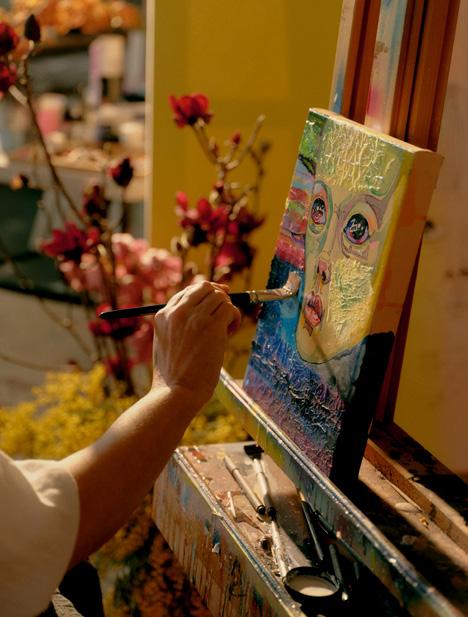
03 Colour bursts from every corner of Barton’s studio. Image: Saskia Wilson. 04 The artist at work; final brushstrokes are added to a new work. Image: Saskia Wilson.

When her son was five and her daughter was three, Barton painted a self-portrait with them, which went on to win the 2008 Archibald Prize. Five years later, she won a second Archibald with her portrait of actor Hugo Weaving. Since then, Barton has solidified her position as one of Australia’s leading contemporary artists. She has held major solo exhibitions, including the highway is a disco at the National Gallery of Victoria in 2017, and participated in international art fairs such as UNTITLED Miami Beach, and Asia Now Paris in 2018. In 2015, Barton expanded her artistic practice into filmmaking with her directorial debut, The Nightingale and the Rose, which garnered multiple awards including the AACTA for Best Animated Short. She continued exploring moving image work with art film Red (2016), featuring Cate Blanchett, and her first feature film, Blaze, in 2022.
Although a spectacular and important piece of cinema, Blaze was an exhausting experience for Barton, its difficult subject matter tearing at old wounds. In February 2022, between finishing filming and the release of Blaze, Barton travelled to the Venice Biennale to visit the exhibition The Milk of Dreams, curated by Cecilia Alemani. The show was filled with surrealist art made by women and non-binary artists that Barton admired, but whose work she hadn’t had the luxury to experience in person. It had a profound effect on her. “I feel emotional just going back to this memory,” she tells me. “I was wandering through this show, and I felt the most profound sense of connection—that this is the art canon I belong to. I haven’t felt that in Australia, or at least not in such a holistic, immersive way. It was confronting, in a way, to suddenly feel that I understood what my historical family was. That’s everything to me.”
However, Barton knows she couldn’t produce the work she makes if she were not Australian. “My works, more often than not, have that strong element of Australia which I’m passionate about, and that really defines space in a very particular way,” she says. It isn’t just her art that’s rooted to place, but her sense of sanctuary. “Even in the busiest parts of Australia, here in the eastern suburbs of Sydney, there’s still, for me, a feeling of tranquillity. A distilled quality. Australia just gives me the right energy to anchor my core self.”
“My works, more often than not, have that strong element of Australia which I’m passionate about, and that really defines space in a very particular way.”
hugo, 2013. Art Gallery of New South Wales. Watercolour, gouache and acrylic on canvas, 200x180cm.
Del Kathryn Barton’s the more than human world will be shown at Albertz Benda, New York from 30 October–30 December 2025.

Barton in her studio workspace, where large-scale works demonstrate the powerful visual language that defines her artistic approach. Image: Saskia Wilson.


Catching the current early

Robin Khuda sold AirTrunk just as the AI boom made data centres indispensable. Now the infrastructure titan is applying his exacting standards to Australia’s most coveted coastal addresses—by Carlie Trotter.
Despite evidence to the contrary, Robin Khuda does not possess a crystal ball. The famously smiley 48-year-old entrepreneur who built and sold hyperscale data centre giant AirTrunk for a staggering $24bn last year—Australia’s biggest acquisition of 2024, perfectly timed for the world-upending AI compute boom—prefers to speak of patterns, courage and the discipline of measured risk. Yet his uncanny ability to identify opportunities years ahead of market consensus has made him one of Asia Pacific’s most successful technology infrastructure pioneers.
“I’ve always been curious about what lies just beyond the horizon and drawn to patterns others might overlook,” Khuda says from his North Sydney office, where floor-to-ceiling windows frame the harbour that first captivated him when he arrived from Bangladesh as an 18-year-old with no money and no network. “Being comfortable with uncertainty and having the conviction to follow through when the path isn’t obvious goes a long way.”
In 2015, when data centres were barely a blip on the public consciousness and ‘hyperscale’ meant nothing to investors, Khuda founded AirTrunk with a vision of vast facilities that would power the digital revolution. The following year, the firm secured a $400m contract but lacked the capital to execute it. Rather than walk away, he personally funded the initial operations until Goldman Sachs and TPG Sixth Street Partners came aboard as early backers.
“I learned that taking risks—when done with care and discipline—can really change things,” he reflects. “It’s about choosing the right moment, understanding why it’s important and being ready to keep going after the decision is made.”
With institutional backing secured, AirTrunk expanded methodically across Australia, then
Digital infrastructure pioneer and coastal developer Robin Khuda.

into Malaysia and Japan. By the time he orchestrated its partial sale to a consortium including Blackstone and the Canada Pension Plan last year, the company had multiplied eightfold in value since 2020, operating across five APAC markets with customers including Microsoft, Google and Amazon. Khuda structured the deal to maintain both leadership and a small equity position.
“We built hyperscale data centres before most people were even using the term, which meant a lot of explaining, a lot of patience and occasionally wondering if I’d misread the room entirely,” he recalls. “You need to balance bold vision with operational discipline and surround yourself with people who aren’t just smart but who believe in the long game.”
FROM CLOUD TO COAST
Alongside his continuing role as AirTrunk chief executive, Khuda established Ondas in 2021, dividing his attention between digital infrastructure and residential architecture.
The boutique apartment developer focuses exclusively on waterfront sites—by definition irreplicable— in Australia’s most coveted coastal
locations. It is a strategic move into a market gap he identified during his own drawn-out property search.
“When searching for my own beachfront home, I realised how limited the options were for people seeking something truly special: a residence that is not only beautifully designed and move-in ready, but also responds to the Australian way of life,” he explains. That insight has been sharpened through dialogue with the Kay & Burton team, who understand exactly which waterfront opportunities warrant Ondas’ attention. “We’re seeing a new generation of buyers, from downsizers ready for their next chapter to returning expats who’ve encountered a certain calibre of design abroad, all searching for homes that feel as exceptional as their life experiences.”
The name Ondas (Spanish for waves) captures the next wave of Khuda’s ambitions, this time in bedrooms and balconies rather than servers and silicon. “After years of building infrastructure at hyperscale, I found myself gravitating toward something more tactile: the way architecture, light and landscape can influence how we live and feel,” he
says. “Creating spaces in locations I personally love—like Palm Beach, Mosman and Sorrento—felt less like a pivot and more like a natural evolution.” Each project begins not with architectural plans but with a core question: how will people inhabit these spaces, day after day, season after season? “Australia’s coastline is unlike anywhere else in the world: raw, expansive and alive. As someone who came from overseas, I’m constantly struck by its power to shape not just the landscape but the way we live,” Khuda reflects. “We begin by embracing a sense of openness, seamless connection between interior and exterior, and a respect for the native environment that is more than just aesthetic—it’s experiential.”
STRATEGIC SHORES
The proof of concept came early last year, when Ondas Manly’s penthouse sold for more than $18m. The six-residence building, designed by Rob Mills Architecture, features a geometric facade with soft curves that echo the beach and breakers below. From there, Ondas has expanded north to Palm Beach, where five apartments
The debut Ondas Manly development offers views of one of Sydney’s most iconic beaches.
will rise beside the heritage-listed Barrenjoey House; across to Mosman, where $32m recently secured a site for six storeys of harbour views; and interstate to Melbourne, where 16 St Kilda apartments are already under construction.
Each location has been chosen for its prime waterfront position and potential to showcase what Khuda calls his “zero tolerance for failure” approach, the same standard that ensures AirTrunk data centres operate with military precision. “As with many things in life, who you choose to partner with is so important. Ondas partners with only the best-in-class architects, builders, landscape and interior stylists,” he adds.
The Manly residences demonstrate this rigour with deep overhangs that temper the summer sun, limestone underfoot that blurs the threshold between inside and out, and kitchen benches carved from single marble slabs that promise both beauty and decades of use.
INTUITIVE LUXURY
With three-bed apartments starting from $8.75m, Ondas buyers seek what Khuda calls “that elusive blend of ease, authenticity and subtle delight” that is the hallmark of world-class hospitality. “We take inspiration from the effortless comfort of a favourite retreat,” he explains, “but rather than trying to create a place that feels like a holiday escape, the goal is to foster a home that enriches everyday living, where the sense of renewal and tranquillity is constant.” This ethos manifests in technology that anticipates rather than intrudes: lighting, climate and blinds respond to weather and time of day, wine storage maintains ideal conditions, music follows seamlessly between rooms.
Khuda’s enthusiasm for the process is palpable. “There’s something incredibly fulfilling about crafting spaces that impact lives, spark connection and become part of someone’s everyday story,” he says. He is applying these same principles to

his own Balmoral project, where he and wife Melea are consolidating a double block with the neighbouring property to create their own tri-level residence, testing every Ondas principle firsthand.
EXPANDING HORIZONS
Perhaps Khuda’s most significant construction project is creating pathways for the next generation. Newly named 2025 Sydneysider of the Year, Khuda made headlines in February when the Khuda Family Foundation donated $100m to the University of Sydney, the largest gift in the university’s history and among the most significant in Australian philanthropy.
The gift funds an ambitious 20-year program to equip thousands of girls from Western Sydney with pathways into STEM, spanning high school outreach, academic mentoring and university scholarships. “My vision, shared with the University of Sydney, is that this program that we’ve created will become a game-changing template that others can leverage and scale in the future,” Khuda stated at the announcement. It is characteristic of his approach to look beyond solving immediate problems in favour of systemic, generational change.
ALWAYS BUILDING
Juggling AirTrunk’s continued growth with Ondas’ expansion would overwhelm most, but Khuda seems energised rather than exhausted by the dual demands. “I’m drawn to projects that require patience and precision,” he acknowledges. Though the entrepreneurial drive never fully quiets, he has learned when to step back. These days, rest means family time, ocean walks, genuine quiet—fuel for the work rather than escape from it.
Different as they are, both ventures define how we will inhabit the future. AirTrunk powers our digital existence; Ondas grounds us in physical space. “We’re creating places with lasting quality and character, designed to fit naturally into their surroundings and support the way people actually live,” Khuda says. Then, with the exactitude that has defined his career: “Every element, from the curve of a wall to the framing of a view, is intentional.”
Khuda’s strategy centres on waterfront residences that capture the essence of coastal living.
THE NEW LUXURY CEILING
How $20 million became Australia’s new normal
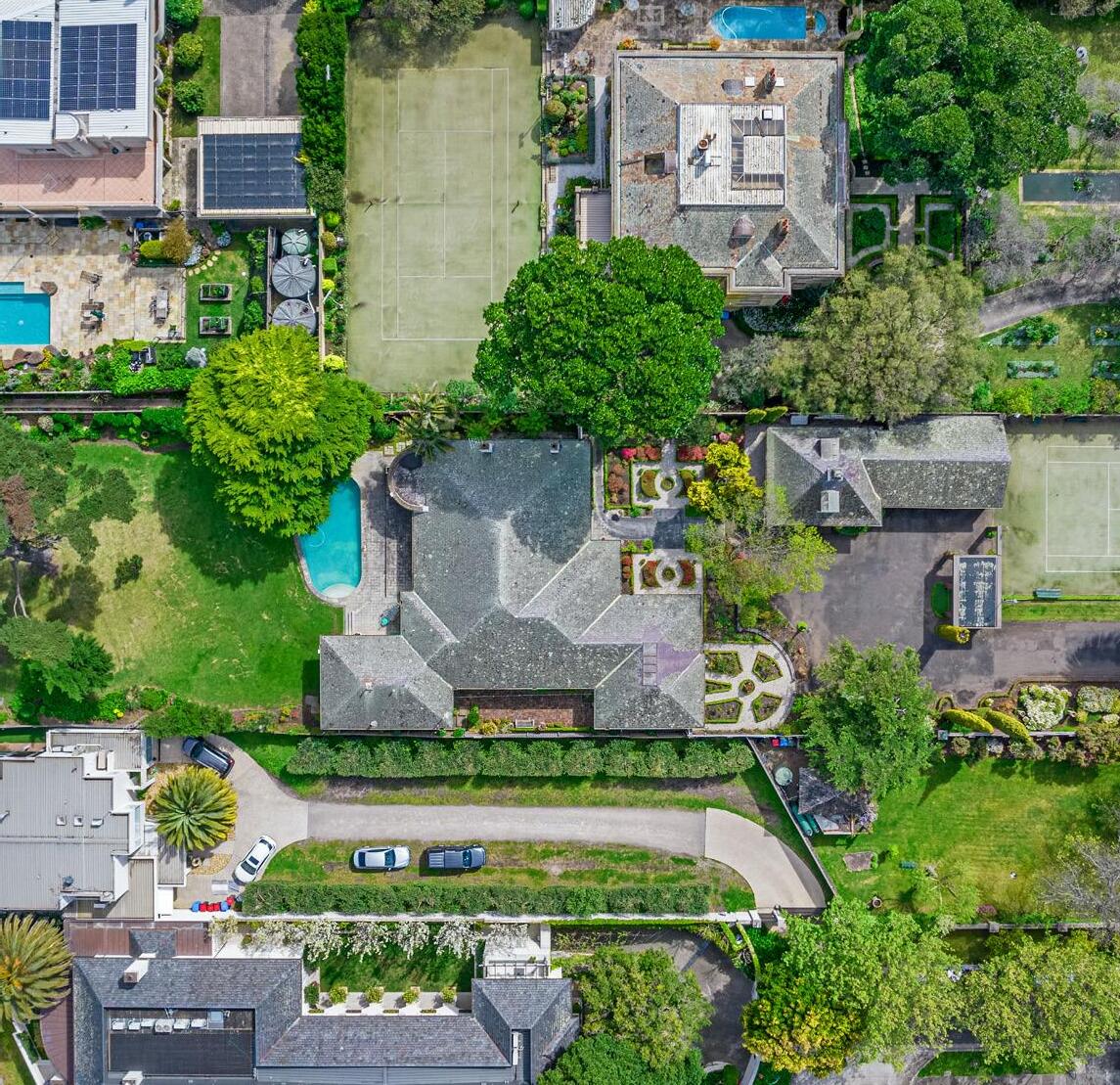
As next-generation wealth drives multimilliondollar transactions, Australia’s luxury property market is witnessing a transformation in both price and prestige—by Kirsten Craze.
While mainstream metrics might demonstrate steady growth in overall property values, it’s the ultra-luxury price bracket (homes sold for more than $10m) that offers a compelling narrative for Australia’s luxury real estate. Increases in elevated transactions reveal that the high-end market is being redefined.
In Melbourne, more than 10 homes boasting eight-digit price tags hit the market in the first week of August alone, while approximately two dozen sold over that price point in the first half of 2025, according to realestate.com.au listings. For Sydney, 15 homes asking $10m-plus came to market in early August, while more than 100 have sold over that benchmark since January 2025. Anecdotally, luxury real estate agents across the country confirm there are dozens more off-market sales topping $10m, suggesting that the scale of ultra-luxury sales is impossible to accurately tally.


At the extreme end of property prices, new thresholds have been surpassed this year in Sydney and Melbourne. A yet-to-be-built three-storey penthouse in Barangaroo fetched more than $140m, while in Victoria, luxury real estate agency Kay & Burton discreetly negotiated two of the state’s most significant transactions ranging between $50m to $150m. The former $31.6m house price record in Melbourne’s suburb of Brighton was also reset with a recent sale on Moule Avenue which sold for an undisclosed figure.
Mark Browning, head of valuations and property advisory at NAB, says today’s ultra-luxury purchasers are largely entrepreneurs who place features such as privacy, security, and a well-being-focused lifestyle high on their wish lists.
“There has always been a segment of buyers drawn to traditional family estates that have been meticulously renovated with every conceivable modern amenity,” Browning says. “But there’s an equally strong demand for contemporary penthouses, whether it’s a beachfront property on the Gold Coast or a harbour-view residence in Sydney, with integrated luxury amenities. Both styles are commanding premium prices, reflecting how diverse luxury preferences have become.”
While luxury real estate purchasers typically skew towards their 40s and 50s, Browning notes that ABS lending data shows there has been a rise in wealthy younger millennials making their move into the multimillion-dollar market.
Financing figures don’t tell the whole story, with a cohort of top-tier buyers unaffected by interest rate movements or borrowing power.
“At the top, interest rate fluctuations have minimal impact. It probably speaks more to confidence in the wider Australian economy, rather than affordability, given these buyers typically transact in cash,” he explains. “But if lower rates spur the general economy and in turn, share market gains and business viability, that creates a stronger correlation for these buyers than mortgage costs.”
Kay & Burton managing director Ross Savas anticipates the high net worth population may undergo fundamental changes over the coming decade, and with that shift may come an evolution of the top-end property preferences and market dynamics.
“Australia is experiencing a massive intergenerational wealth transfer that represents a once-in-a-generation economic shift with global implications and the momentum is already building,” Savas explains. “Additionally, we’re seeing significant wealth creation from entrepreneurs in technology and digital commerce, a trend that is expected to accelerate in the near future.”
The weakened Australian dollar presents another driver in the luxury property sector. Sitting at or below USD$0.65 for most of the year, the Australian currency presents an enticing value proposition for offshore buyers.
“The lower Australian dollar positions our property market in a favourable light worldwide,” Savas explains. “We’re seeing substantial interest from expats and offshore buyers who are eager to buy here. Both our overseas client database and international business meetings reflect that demand.”
Research shows that on a global stage, Australia’s top 5% of most expensive homes offer impressive “bang for buck.” According to Knight Frank’s The Wealth
Report 2025, US$1m (AUD$1.53m) buys 45sqm of luxury Sydney real estate, while the same amount would secure 87sqm in Melbourne. These metrics represent extraordinary buying power when compared with other cities such as Hong Kong, Singapore, London, New York or Geneva, where US$1m bought less than 40sqm of prime property in 2024.
Jamie Mi, partner and head of international at Kay & Burton, says Melbourne’s luxury property market continues to represent outstanding value for overseas purchasers. “Melbourne remains significantly affordable relative to comparable global cities and emerging luxury markets,” she says. “By October this year, we predict a new wave of curiosity and powerful overseas inquiry, specifically from China, Hong Kong, Singapore, the US and Vietnam.”
“Already, we’re witnessing shorter settlements, even for homes selling for up to $40m, and a resurgence in the all-cash purchaser,” Mi adds. “Should the Australian Government expand immigration pathways, it may create another decade-long wave of demand in the top-end suburbs. Ultimately, we remain competitively priced against other global cities while offering strong long-term growth potential.”
01
02
03
04
04

OF CROWNS, STARS
From Paris to Patiala, tiaras to Tutti Frutti, a landmark new exhibition traces how jewellery house Cartier became a global icon of luxury and innovation— by Praachi Raniwala.

At London’s V&A Museum, a diamond tiara greets visitors with quiet brilliance. The Manchester Tiara, created by Cartier in 1903 for Consuelo, Dowager Duchess of Manchester, stands not just as the opener for this exhibition on the storied Parisian brand—it captures Cartier’s story in miniature.
The tiara’s significance lies as much in its story as in its setting. “It was made in Paris, for an American heiress marrying into English aristocracy,” explains Helen Molesworth, senior curator of jewellery at the V&A and lead curator of the exhibition. It embodies the international reach, cultural cachet and modern vision that turned a modest Parisian workshop into the world’s most influential jeweller.
This global perspective became Cartier’s defining characteristic. The exhibition reveals how the three brothers—Louis, Pierre and Jacques, grandsons of founder Louis-François Cartier—strategically positioned themselves across three continents. “They set themselves up in Paris, London and New York, beginning the globalisation of Cartier,” explains Molesworth.
It was this rare blend of daring design, flawless craftsmanship and border-transcending inspiration that propelled Cartier into one of the world’s most forwardthinking jewellery houses—establishing a blueprint that global luxury brands still follow today.
A RARE GEM
“The three brothers looking to the world around them was the beginning of what we now recognise as the Cartier style and heritage,” says Molesworth. “Jacques travelled through India, the Middle East and Sri Lanka; Pierre explored Russia; Louis found his muse on the streets of Paris.” From Egypt to China and India, no source of inspiration was off limits.
In doing so, Cartier built a vocabulary of design that was light, modern and strikingly ahead of its time while still feeling of-the-moment. The maison’s signature garland style revolutionised 20th-century jewellery, replacing the weighty Victorian aesthetic with an airy play of materials. “Every generation since has tapped into [contemporary trends], but always with a nod to heritage rooted in creativity and craftsmanship,” adds Molesworth.
Over 175 years, this ethos has produced countless icons: the Tank and Crash watches, the exuberant Tutti Frutti necklaces, and legendary pieces for Elizabeth Taylor, Princess Grace of Monaco, and Queen Elizabeth II—whose pink diamond Williamson brooch was famously worn to Prince Charles and Lady Diana’s wedding.
JEWELLER OF KINGS
Founded in Paris in 1847, Cartier’s ties with royalty cemented its reputation as “the jeweller of kings and the king of jewellers.” In 1907, Cartier created the trousseau jewels for Princess Marie Bonaparte, Napoleon I’s greatgrandniece, who was marrying into the Danish-Greek royal family. Prior to delivery, the maison displayed the pieces at its Rue de la Paix showroom in Paris— a masterstroke of early luxury marketing.
Two decades later, in 1928, came an even more monumental commission—a ceremonial necklace for Maharaja Bhupinder Singh of Patiala in India. At 1000 carats and composed of 2930 diamonds, it remains the largest necklace ever created by Cartier.
Grace Kelly’s emerald-cut Cartier engagement ring cemented the maison’s influence in luxury jewellery. Image: The Princess Grace Foundation.
& STONES

“Cartier came up with brilliant ideas in the 20th century that we now call marketing,” says Molesworth. “But it only worked because the jewels themselves were extraordinary. You cannot sustain 150-plus years of success without being rooted in quality.”
THE FAMILY LEGACY
“The unshakeable bond of the three brothers was the magic ingredient,” says Francesca Cartier Brickell, great-granddaughter of Tutti Frutti mastermind Jacques, and author of acclaimed 2019 book The Cartiers. This human dimension, she explains, was “the essential element my grandfather [Jean-Jacques] felt was absent from publications about the firm and its creations.”
Francesca’s research revealed the extraordinary depth of the brothers’ relationship. Initially, she questioned whether the family stories might be romanticised. “My grandfather had told me how his father and two uncles would do anything for each other, so much so it annoyed their wives,” she recalls. “But I always wondered if this was an exaggerated family legend passed down with rose-tinted spectacles.”
Then she discovered proof in decades of correspondence. Pierre wrote to Jacques during WWI: “You know from experience that my two brothers mean everything to me. It’s together that we dreamed of the greatness of our house; it’s together that we developed it and spread its fame to the four corners of the globe.” As Francesca puts it: “This wasn’t a fairy tale—it was documented reality.”
For Francesca, this family spirit lives on at the exhibition. The Cartier London Stag brooch—never before displayed publicly—particularly resonates. “It was the piece my grandfather Jean-Jacques was most proud of,” she explains. The brooch, created as a wedding anniversary gift for her grandmother’s sister, embodies the family’s “commitment to ‘never copy, only create,’ their belief in taking time to do something properly, and that magical collaborative spirit between designer and craftsman.”
The exhibition reminds us that jewellery is never mere ornamentation, notes Molesworth. “When you look at Cartier, you see how the world has changed, how it has responded to jewellery, and how one of the greatest maisons of all time helped shape the story of the 20th century.”
Ultimately, Cartier’s genius lay in both design and marketing strategy. Through limited production and placing pieces on celebrated women, every move created desirability that fed the brand’s global mythology—turning objects into symbols of power.

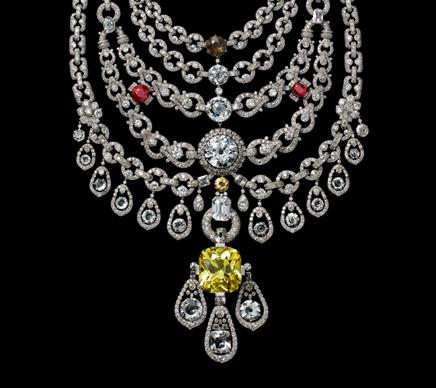
01 Manchester Tiara, Harnichard for Cartier Paris, 1903. Commission for Consuelo, Dowager Duchess of Manchester. Diamonds, gold and silver; the C-scroll at each end set with glass paste.
02 Brooch, Cartier London, 1933. Amethyst, sapphires, diamonds and platinum. Image: Vincent Wulveryck, Collection Cartier.
03 Patiala Necklace, Cartier Paris, special order, 1928 (restored 1999–2002). Commissioned by Bhupinder Singh, Maharajah of Patiala. Diamonds, yellow and white zirconia, topaz, synthetic rubies, smoky quartz, citrine set in platinum. Image: Vincent Wulveryck, Collection Cartier.
Cartier is showing at the V&A South Kensington (London) until 16 November 2025. vam.ac.uk
With countless ventures under his belt, Australian businessman Nick Bell has made momentum his trademark. His latest obsession applies the same systematic approach to the ultimate challenge: redefining what it means to age—by Adam Turner.
The eternal entrepreneur
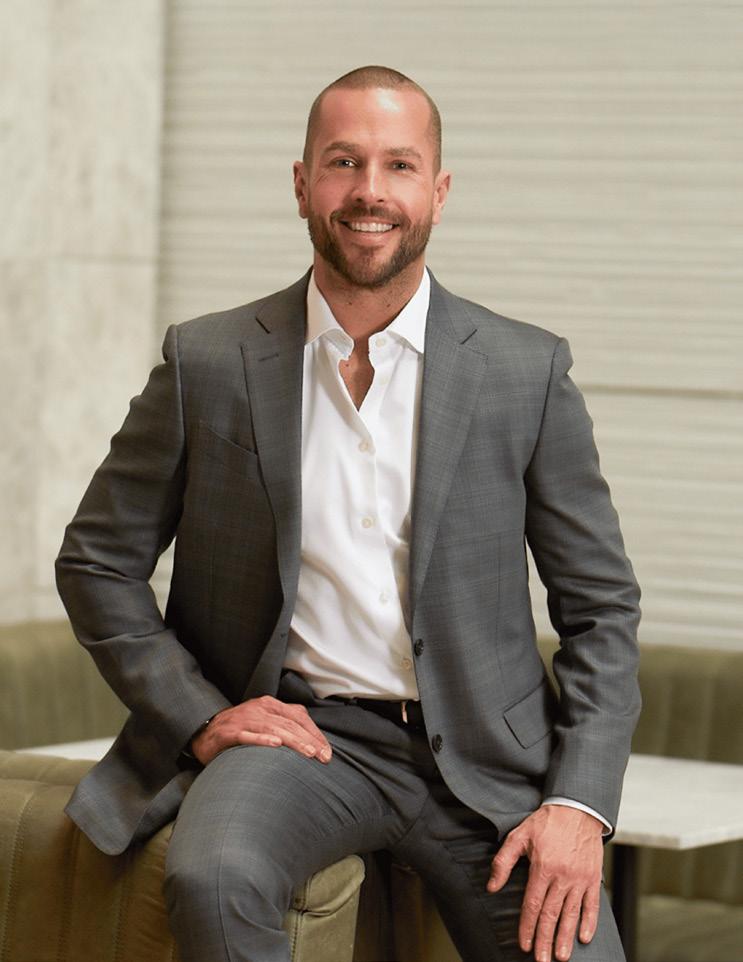
Running his first side hustle from a high school locker in the 1990s, enterprising farm boy turned rich-lister Nick Bell set off early on the road to success. Growing up on a sheep and cattle farm in Mount Macedon, northwest of Melbourne, Bell dreamed of the big city lights. Determined to make it a reality, the ambitious teenager set his sights on moving to London and went to work raising the cash for a plane ticket.
“I was always hustling to make money,” Bell says of his school years. “That [attitude] comes from my father. He had a couple of businesses, they weren’t all that successful, but he always had the itch for it and I thought that was amazing. When I was young, I thought being an entrepreneur was like being a movie star, offering the freedom to march to the beat of your own drum, and I wanted that life, even though I wasn’t sure if it was attainable.”
Determined to make the dream a reality, Bell wasn’t content to wait. Setting up shop in his locker at recess, he started leasing out sports equipment, computer games and videos to fellow students. He even sold his school lunches to raise cash, going hungry in his first taste of hustle culture which prioritises work and ambition over all else.
Thanks to his extraordinary drive, Bell finished high school with enough funds to get him to London, where he worked in bars before returning to Melbourne to study marketing. His academic career lasted six weeks before he returned to hospitality work. With his sights set on bigger things, Bell bluffed his way into a data entry job by claiming he could touch type, then moved to sales where he quickly climbed the ranks.
By age 24, Bell says he was tired of climbing the corporate ladder to make others rich. Determined to put his sales skills to work for himself, he founded his own skincare business focused on a tablet-based acne treatment. In a harsh reality check, after three years of hard work, the reality was sobering: he was still earning a mere $75 a week from the business.
While the fledgling skincare business didn’t completely fail, it never took off, hampered in part by supply chain issues and an inability to scale. The setback offered Bell valuable lessons about resilience and execution—but perhaps more importantly, it crystallised his understanding of what drives him.
“An ex-girlfriend said to me many years ago, ‘you’re too dumb to realise you’re going to fail’,” he says. “The problem she saw was that I didn’t focus on the negatives—I always looked at the upside and how I was going to succeed.”
It is a trait he’s come to both embrace and examine more critically over the years, admitting it does not always serve him well. “But I’ve learned that [what drives] success is not just spotting a good idea—it’s also knowing how to execute and bring the opportunity to life.”
In 2008, aged 28 and living in a Richmond sharehouse with only a few hundred dollars to his name,
Bell needed a new plan. Rather than looking for a job, he decided to pivot and teach himself the then-emerging art of search engine optimisation. Founding digital marketing company Web Marketing Experts (WME) in his bedroom, he started cold calling thousands of businesses that featured on the second page of Google search results—promising to improve their search ranking while undercutting their existing marketing provider.
This time around, tapping into pent-up demand and nailing the execution, Bell’s project paid off. He was making money within days and had netted around $2m by the end of his first year. The business grew to a headcount of more than 300 before he sold WME to Melbourne IT for $39m in 2017.
The deal put the then-37-yearold on the AFR Young Rich List, but rather than rest easy, he already had several other irons in the fire. Chief among them was mobile application development agency Appscore, which Bell and former flatmate Alex Louey bootstrapped with just $3000 in 2010, growing it into a $25m global business which morphed into enterprise software developer Trideca. Beyond WME and Appscore, Bell has founded or co-founded more than a dozen companies worldwide, including fast-growing Removify (which made Deloitte’s Technology Fast 50 list in 2021) and digital marketing agencies across multiple markets. He also maintains an active investment portfolio spanning ventures globally.
However, not everything Bell touches turns to gold. He’s pulled the plug on several underperforming startups, though he frames these as necessary learning experiences rather than failures. “If you want to [succeed] then you can’t let fear of failure hold you back,” he says. “I’ve had multiple
“I enjoy building things, but I can’t sell a service or a product that I’m not happy with, so I will shut the business down rather than let it flounder.”
businesses fail—not because they ran out of money but generally because the product offering wasn’t right. I enjoy building things, but I can’t sell a service or a product that I’m not happy with, so I will shut the business down rather than let it flounder.”
Despite these setbacks, Bell’s wins have far outweighed his losses. Capitalising on his successes, the 45-year-old today has a net worth of more than $600m. His profile has led to television appearances, including Celebrity Apprentice Australia in 2022 and a more recent judging role on Shark Tank Australia, where he mentors aspiring founders.
In Bell’s eyes, those who run their own business share a common drive. And while some might work hard in the hope they can eventually sit back to enjoy the fruits of their labour, he says the difference is that for someone like him, the work is never done. “Rather than just pick one thing and do it well, I’m always looking for new opportunities and chasing that next shiny object,” he says. “I enjoy the game of starting and building businesses, but it [comes with] a lot of stress and hard work.”
The personal toll, he acknowledges, extends beyond just him: “I know this is to my own detriment—and causes my wife pain and anguish— because instead of one big business to worry about I have multiple smaller businesses to keep me very busy.”
For Bell, success is not about constant reinvention—it is about spotting market trends early and adapting quickly to capitalise on emerging opportunities. This philosophy has served him well throughout his career. Just as he taught himself SEO almost 20 years ago to build his digital marketing empire, today he is undertaking a deep dive into artificial intelligence.
While the technology’s potential is dominating headlines and has investors excited, Bell argues that accessibility remains a major hurdle for businesses. Many are unsure where to start, or struggling to implement AI tools effectively, which hands a competitive edge to their more techsavvy competitors. Determined to be on the front foot, Bell has hired a team of four full-time specialists to proactively identify weaknesses within his organisations that AI can address.
01
But he is adamant it should not come at the expense of human connection. “I’m a massive believer in building relationships with people, and AI is never going to replace that,” he says. “If you’re a salesperson, I can’t see AI taking over your position anytime soon. Other roles which rely less on people skills are obviously more at risk, but I think AI works synergistically with people—so rather than fear it, the smart play is to embrace it and understand how it can make us better at what we do.”
Despite championing new technology for business challenges, Bell has never fallen for the trap of viewing tech as a productivity panacea. He unashamedly sticks with pen and paper when it comes to writing his daily to-do list and getting things done. “I know it’s quite old school, but they say ‘out of sight, out of mind’ so I always keep my to-do list in sight,” he says. “It’s not just the satisfaction of crossing things off—it’s that a written list on my desk keeps me on track and reminds me to action those items quickly.” Bell’s approach to goal-setting follows a similar low-tech philosophy. “Meanwhile, the screen saver on my laptop is a bigger list of goals that I intend to achieve in the quarter ahead, so I’m reminded of them every day.”
It’s a refreshingly analogue approach from someone so digitally savvy. As someone who could be seen as a poster boy for hustle culture— which often glorifies overworking at the expense of personal wellbeing and work-life balance—Bell has a more nuanced take on the grind.
“I always say to people ‘the harder I work, the luckier I become’, meaning the more I put in, the more I get back,” Bell says. “You don’t need to sacrifice your health to find success—for me,

exercising in the morning is more important than a board meeting.”
It is this creed that underpins his latest enterprise: longevity clinic Super Young, which is dedicated to “cracking the health span code.” Establishing the first clinic in Melbourne’s Armadale, with plans to expand along the east coast, Super Young offers tailored wellness programs aimed at helping members stay mentally and physically healthy well beyond 100 years old. Bell is also launching a digital clinic offering access to doctors who specialise in regenerative medicine.
“Money doesn’t buy you happiness, it buys you opportunity—not just to live as long as you can but also to live as well as you can,” he says. “I don’t want to live to be 100 years old if I’m buckled over in a wheelchair. To me, ensuring you remain vital and healthy is the key to true longevity.”
For Bell, investing in his own health, and that of others, is a smart investment, with McKinsey estimating
the booming consumer wellness market to be now worth US$1.8tn globally. The self-confessed “biohacker” recently spent $700,000 on injections to alter his genes in a bid to improve memory function, ward off dementia and increase muscle mass and strength. Along with daily medications and weekly intravenous infusions, he spends 30 minutes each morning in a cold plasma human regenerator bed, a device that generates a field of ionised air with the aim of supporting the body’s natural repair processes.
Age has forced him to face his own mortality but, as an entrepreneur who believes there’s an answer to everything. Bell views even death as a problem to be solved.
“Combining healthcare with emerging technologies like AI, I think age will actually start reversing within 10 to 15 years from now,” he says.
“I keep telling my friends, just stay alive for another 10 years and you’ll live well beyond 100.”
Startup veteran Nick Bell is now applying his expertise to the challenge of extending human lifespan.
02 The cryotherapy chamber at Super Young in Armadale, Bell’s latest business venture.
GROWING CULTURAL CAPITAL
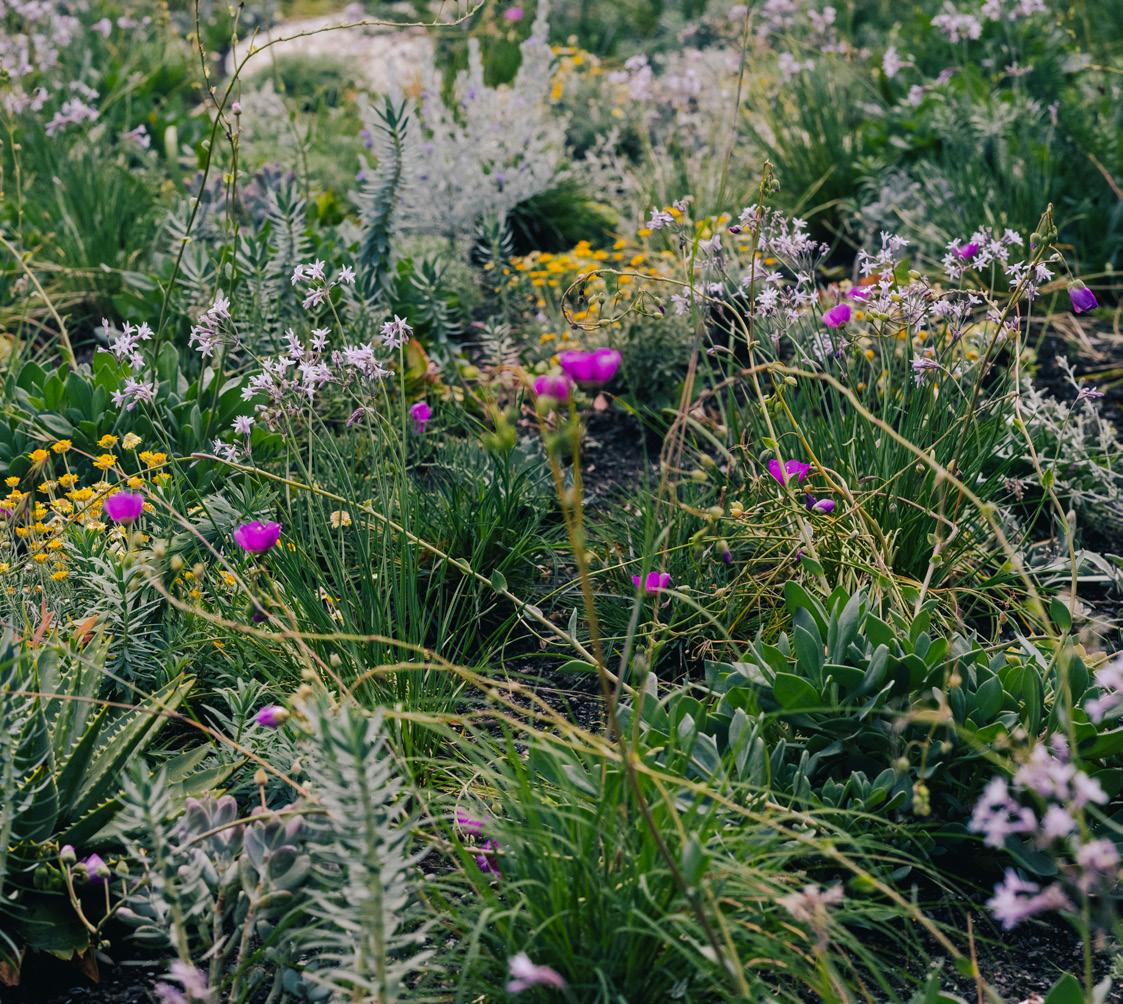
From New York’s High Line to London’s Olympic Park, cultural gardens have become magnetic destinations in their own right. Now Melbourne is joining the movement, with a bold reimagining of what urban green space can achieve—by Peter Barrett.
On the edge of Federation Square’s sprawling carpark, an office worker is perched on the roundabout with her Tupperware lunch. It’s a relatively quiet place, save for the intermittent school bus dropping off or picking up. The view is pretty ordinary—asphalt, cars, infrastructure—not a place you’d ordinarily choose to linger with the Yarra River so close. But that was before the Test Garden arrived.
Today, lunch looks different. Canary yellow Cats Tails (Bulbine bulbosa) bob in the breeze as bees fuss about from one vivid purple South American Cistanthe grandiflora flower to another. Clumps of flowering violet Chocolate Lilies (Arthropodium strictum) jostle for room with autumnal hued succulents, while native Kangaroo grasses burst forth among the choreographed chaos, their long stems heavy with shaggy, star-shaped seed heads.
Welcome to the Laak Boorndap Test Garden. Designed by design firm Hassell in collaboration with leading UK horticulturalists James Hitchmough and Nigel Dunnett, alongside Australian plant expert Jac Semmler of Super Bloom, this tiny prototype planting is set to be scaled up to cover 18,000sqm—about the size of the MCG—wrapping around the forthcoming Melbourne Arts Precinct, which will connect 50 venues including Hamer Hall, a refurbished Arts Centre, NGV International and brand new The Fox: NGV Contemporary.
Above: Native plantings at Laak Boorndap’s Test Garden reflect the biodiversity principles driving the ambitious civic project. Image: Sarah Pannell.
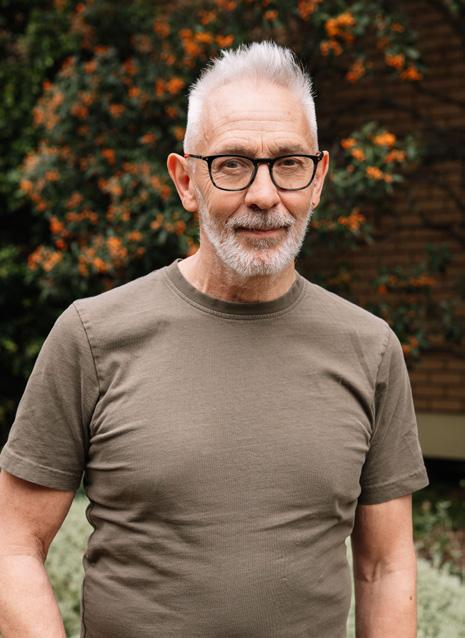
The total cost of the Victorian Government’s Melbourne Arts Transformation project investment is $1.7bn.
But Laak Boorndap—named by Traditional Owner and Wurundjeri Woi-wurrung Elder Aunty Gail Smith—will be more than just a pleasant lunch spot. When it opens in 2029, it will be the most ambitious example yet of a global green movement. From the High Line in New York and London’s Southbank Centre, to Hong Kong’s M+ West Kowloon District, gardens are becoming central to how leading cultural institutions engage with communities, promote ecology and foster cultural connection.
Katrina Sedgwick, director and CEO of MAP Co, the authority responsible for delivering the project, says data worldwide shows gardens attract visitors. Botanical gardens and parks have done so for centuries, but what’s new is how contemporary interventions in dense urban spaces are proving transformative. They don’t just boost wellbeing for locals—they’ve become destinations in their own right. “They are, in and of themselves, hugely popular,” Sedgwick says, with visitor estimates for Laak Boorndap exceeding 4.5 million per year.
The key here is design. Forget your clipped lawns, cropped hedges and token rose beds. Picture instead complex, biodiverse ecologies of riotous colour that bloom year-round, changing not only with the seasons, but month to month.
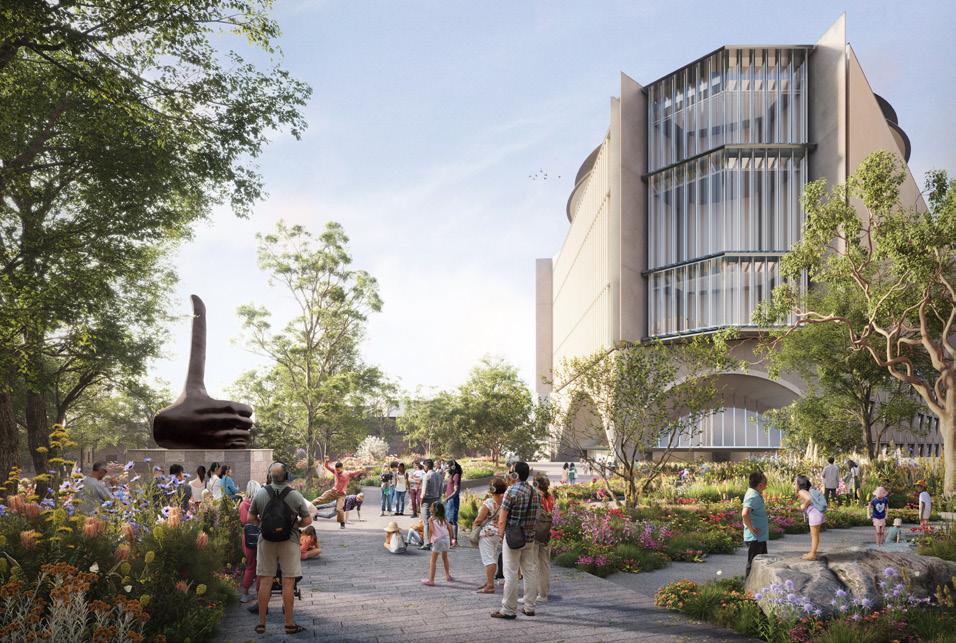
Leading UK horticulturalists James Hitchmough (pictured) and Nigel Dunnett are leading the project. Image: Phoebe Powell.
Future vision of Laak Boorndap, the ambitious cultural garden that will anchor the Melbourne Arts Precinct.
That was the pitch from University of Sheffield horticulturalists James Hitchmough and Nigel Dunnett for Melbourne’s Laak Boorndap. The pair rose to fame when their 2004 book The Dynamic Landscape: Design, Ecology, and Management of Naturalistic Urban Planting won them the job reimagining Queen Elizabeth Olympic Park in London—10ha of former industrial land transformed into a living, flowering spectacle of vast, biodiverse meadows. Olympic audiences were dazzled. A new benchmark for urban ecological design was set. Hitchmough, who lives in Somerset, England, has strong Australian roots. He spent a decade here in the 1980s teaching horticulture at the University of Melbourne’s Burnley Campus (his students included Paul Bangay). During this period, he became a passionate advocate for Victoria’s endangered Western Plains grasslands. Today he remains a dual Australian-British citizen. For more than 30 years he has worked with fellow Sheffield professor Nigel Dunnett, promoting a philosophy that Hitchmough describes as the fusion of “ecological science, design and people’s cultural responses to vegetation.”
In other words, they’re chasing the “wow factor”. Dunnett and Hitchmough want visitors to feel something. They know that not everyone will approve—their plantings mix local, endemic, native, and (gulp) exotic species—but behind it lies a pragmatic truth: the climate is changing and if we want to preserve biodiversity, especially in cities, we need to think differently.
It’s also about seeing urban vegetation differently. “Rather than filling space, like a green antidote to concrete, it’s seeing this stuff as actually having a role in terms of human wellbeing,” says Hitchmough. “So, you invest more in it, because people who are interested in gardens, they live longer,” he enthuses.
Laak Boorndap will feature a mix of 450 different species, all tested by University of Melbourne researchers for drought and climate resilience over three years. (Some climate models suggest Melbourne could feel more like Dubbo by the end of the century.) The designers hope these gardens will inspire people to adopt this planting ideology at home or in public places to support biodiversity.
Maintenance will be the ultimate test. Gardens need gardeners. In Britain, Hitchmough notes, biodiversity credits—similar to carbon trading schemes—can fund urban horticulture. Australia legislated a biodiversity market in 2023 but it remains voluntary. “All gardens are really processes, not products,” he contends. “The nature of most gardens, both historical and the sort of weird, wacky stuff that we make, is all about change. It’s about trying to manage change in ways that are still acceptable but accepting that change must take place.”

Back in Melbourne, lead project consultant and Australian design practice Hassell is working with New York architects SO-IL, specialists in cultural buildings, towards a vision of a garden that can be thoroughfare, picnic spot, performance space and sculpture park, all rolled into one. Principal architect Jon Hazelwood was keen not to replicate New York’s High Line, but to embed zones inspired by Victoria’s volcanic grasslands and the Dandenong Ranges.
And, if the Test Garden at Federation Square is anything to go by, things look promising. “That has taken everybody by surprise,” Hazelwood observes. “We’ve been overawed by how popular a small area of planting that is a sixtieth the size of the final project has been.” Work is also being undertaken to ensure non-humans are also welcomed to the site, including critters like the native blue-banded bee and local honeyeaters. Sedgwick is equally confident. She believes Laak Boorndap will be a destination for tourists, a retreat for workers and students, and a civic space that supports wider efforts to adapt the city to a changing climate. “It’s going to be absolutely beautiful.”
The new garden will be integrated into the city’s existing arts precinct, framing landmarks such as Arts Centre Melbourne.
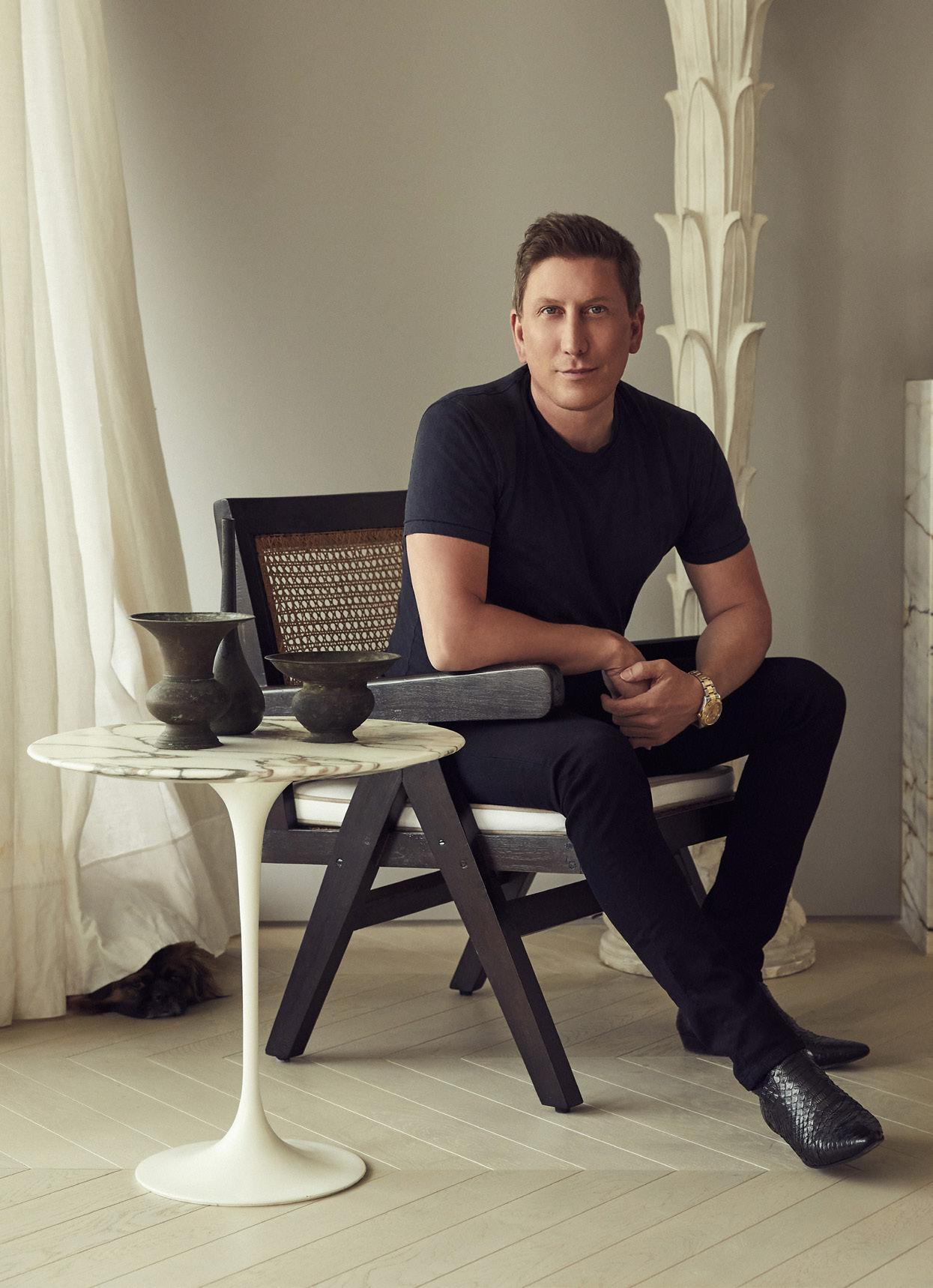
Above: David Hicks has left his mark on Australian residential interior design.
Right: Clement Meadmore sculpture, artwork by Dale Frank.
LUXURY
Over 25 years, Melbourne-based David Hicks, a seminal figure in Australia’s contemporary residential design, has elevated domestic spaces into sanctuaries of considered sophistication, where his signature approach weaves together refined rationality with rich, expressive layers—by Alice Blackwood.

THE SEEKER’S EYE
Though now synonymous with Melbourne’s design scene, David Hicks’ distinctive aesthetic has its roots far from home: his childhood in 1970s Malaysia, where colonial grandeur met modernist sensibility.
His mother—an architectural draftsperson and art gallery owner— orchestrated their Californian bungalow home as a masterclass in sophisticated eclecticism.
“You had these [grand] colonial buildings, but then inside a more relaxed interior,” Hicks recalls, describing the early spatial contrasts that would go on to shape his design philosophy. His mother’s curation represented what he calls a “quiet”
fusion—European, Asian and Middle Eastern elements combining to create an atmosphere where diverse influences converged without competition.
The details remain vivid in Hicks’ memory: Chinese cabinets inlaid with precious stones standing alongside classic French Louis-style chairs, cane seating, a marble-topped table supported by a delicate timber base, and Persian rugs anchoring the eclectic ensemble. “It was very decorative minimalism,” he reflects. “That midcentury modern foundation, overlaid with a mixture of European, contemporary, Asian pieces, Middle Eastern rugs, and antiques was quite
formative to the way that I design,” Hicks explains.
With his intuitive sensitivity for contrast, balance and materiality, Hicks is not averse to bold material contrasts or the integration of sculptural furnishings. Yet he anchors every design decision in fundamental principles: composition, proportion and narrative remain the cornerstones of interior balance and cohesion.
“Design is about discipline, but also intuition,” he reflects. “You need to instinctively know when to push, when to edit, and when to let the architecture breathe.” This philosophy has crystallised through decades of practice into a deeper understanding of luxury

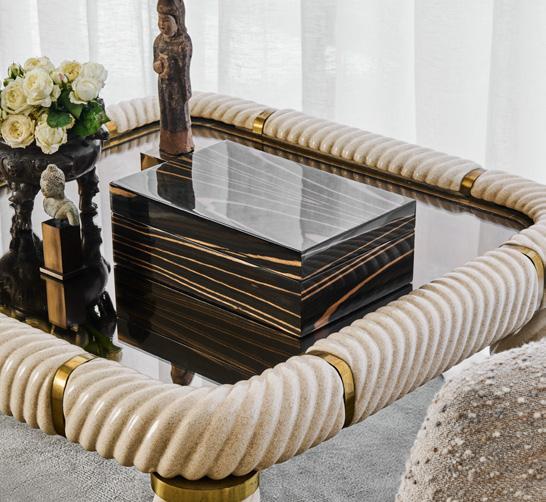
“True luxury isn’t about excess—it’s about refinement, craftsmanship, and creating spaces that people truly want to live in.”
itself. “Over the years, I’ve learned that true luxury isn’t about excess—it’s about refinement, craftsmanship, and creating spaces that people truly want to live in.”
This creative rigour, the deep nostalgia held for the stylistic fusions of his childhood home, and the early influence of living abroad—existing simultaneously as a visitor and a resident within a foreign culture—has nurtured Hicks’ own curiosity and distinctive penchant for collecting.
More than a collector, Hicks is a seeker. He believes a collection can be founded on a single piece, following lines of interest, curiosity, memory, and affinity for particular cultures or eras. His home and office serve as intimate galleries, filled with thoughtfully acquired pieces that reveal the rich tapestry of his creative mind’s eye.
His love of objects of cultural significance and decorative beauty finds its most profound expression in his extensive collection of Buddha heads—discovered, collected and acquired throughout his many years of travel and keen pursuit.
“I have an affinity towards Asian crafts, objects and furniture, so I started collecting Buddha heads,” he recalls. “Every country I’d go to, I’d purchase one. I’ve collected Indonesian, Thai, Chinese, Cambodian, Laotian, even Afghan Buddha heads.” For Hicks, the allure lies in the craftsmanship of these objects—their finishes of bronze and stone, placing a sentimental value upon them that may often exceed their actual worth or perceived collectability. “I think they are beautiful objects that have a history to them, and remind me of the countries I’ve been to.”
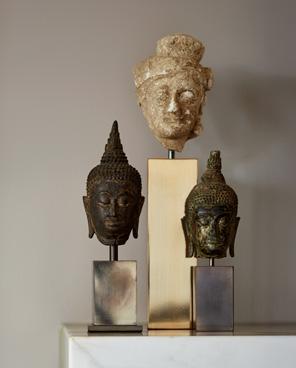
That distinctive fusion of historical and midcentury sensibilities continues to inform both Hicks’ creative approach and restless seeker spirit. “I think my design work has a very midcentury modernist undertone,” he explains. “It was an era of change in which everything shifted away from the antique to being quite streamlined; shapes became simplified—organic and aerodynamic, materials changed to chrome, stainless steel, beautiful exotic polished timbers.” Yet antiques retained their relevance during this time: “They were mixed in with this new life, this new world,” he observes. Drawing from these same principles, Hicks quietly pursues iconic midcentury Italian lighting and other Italian or French furnishings from the midcentury period. “Those items have a lot of history—the designers, the
Antique French marble bust.
Vintage Italian side table by Tommaso Barbi, Anton Gerner Macassar ebony box.
From Hicks’ collection of Asian sculptural art: Thai bronze Buddha head, Afghani sandstone carving, Burmese bronze Buddha head.
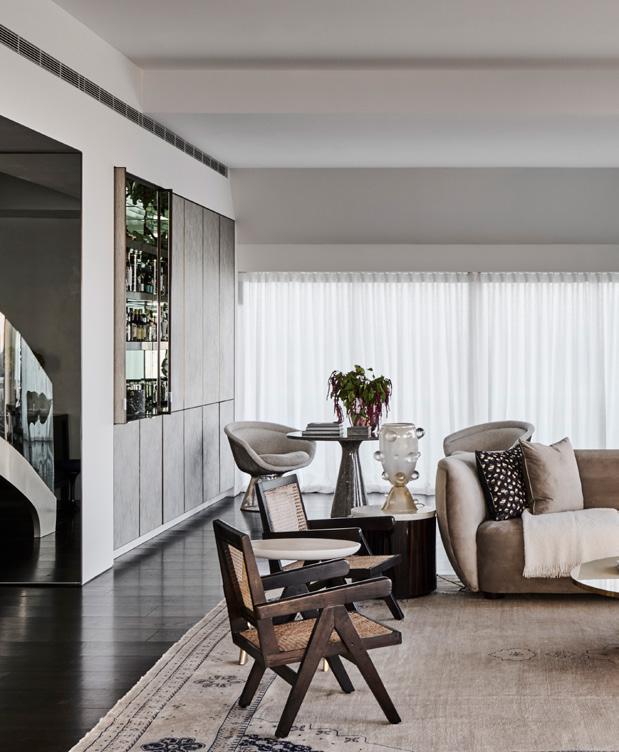

materials they’re made from, the very era of change that they represent,” he explains. Again, these carefully chosen pieces fill his home and workspace, lived in and among, enjoyed in a functional capacity as much as they are in an objectified sense.
Hicks’ aesthetic sensibility extends beyond interior spaces, manifesting in an appreciation of contemporary Australian art—with the work of painter Dale Frank being of special interest— and fashion. An avid collector of shoes— Tom Ford, Saint Laurent, Louboutin, Louis Vuitton among them—he regards them not merely as footwear, but as sculptural objects worthy of contemplation.
Here, his collecting philosophy channels broader cultural shifts, as he considers his passion for collecting boots as something belonging to a
more formal time, pre-pandemic, when we all made an effort to put our best foot forward, so to speak.
While the widespread transition to sneakers mirrors our collective embrace of casual living, for Hicks, it represents something deeper: a philosophical evolution as he moves from reflecting on 25 years of practice toward envisioning the next quartercentury of design.
As he celebrates this milestone in business and design, Hicks considers it not merely as an achievement, but “an end to that body of work”—a natural conclusion that creates space for renewal. “It’s nice to have a fresh point from where to start,” he reflects, while qualifying that he doesn’t see his future being a radical departure from his past.
“I think the world is changing, people’s lifestyles are changing so, for
me, it’s about relaxing the style, being less rigid and more tactile,” he explains. Despite this, he believes a cyclical rebound to a more elevated aesthetic is inevitable. “As we continue on in this ‘comfort era’ I think there will be a return to materials that are more glamorous—highly polished, very slick—but it will be contrasted against textures like exposed brick walls and concrete floors, for example. It’s this warmth alongside industrial elements that really resonates with me.”
For David Hicks, the nostalgia of eras past continues to be tempered by the industrious creativity of progress, and he positions himself at the centre of this dynamic—collecting by way of meditation and reflection, and designing by way of contribution.
Thoughtfully chosen pieces such as this original 1960s Pierre Jeanneret Chandigarh chair and Murano glass lamp define the Hicks aesthetic.
A distinctive tableau: vintage Italian bamboo console paired with contemporary Jonny Niesche artwork and Murano Seguso glass.

01 25 Barry Street, Kew
Securing an extraordinary result one week prior to officially launching to market, this landmark Studley Park residence was sold off-market after our strong relationship with a trusted buyers’ advocate enabled the introduction of the perfect purchaser— a young family who had been searching for over a year. With a $15–$16.5m price guide, the property’s rarity prompted decisive action before it reached the public. Set on 1800sqm* of Paul Bangay–designed gardens, the fully renovated Victorian mansion features five bedrooms, five bathrooms, a triple basement garage, home cinema, and poolside gym. Sold by Scott Patterson and Garrick Lim.
02 16 Moule Avenue, Brighton
Setting a new benchmark for Brighton, ‘Teychel’ drew significant interest both locally and internationally, culminating in multiple offers from across the globe. Spanning 4500sqm* in the prestigious Golden Mile, it is one of only a select few estates to extend from street to shoreline— complete with private beach access, a boatshed, tennis court, and pool. In its 100year history, the sale marks only the third owner, preserving its rare combination of
scale, privacy, and privilege. The campaign generated exceptional exposure, cementing its status as a once-in-a-generation opportunity. Sold by Ross Savas, Alex Schiavo and Jamie Mi.
03 6 Seymour Grove, Brighton
This landmark Brighton residence was introduced to the eventual purchaser ahead of its public release, ensuring they experienced the home in a private, considered setting. The subsequent campaign—with its striking photography and strong editorial coverage—only reinforced its appeal, capturing widespread attention and confirming the home’s position as a significant Bayside offering. The sale was a testament to the strength of Kay & Burton’s network and the precision of a targeted campaign—qualifying buyers, generating significant enquiry, and securing the right custodian for this truly unique Brighton icon. Sold by Alex Schiavo, James Driver and Shantelle Francis.
04 46 Canberra Road, Toorak
An international client—nurtured through a long-standing Kay & Burton relationship— flew to Melbourne with the intention
of securing a premier residence. Over the course of one day, we curated and personally hosted private inspections of a select number of properties, culminating in the acquisition of this landmark Wayne Gillespie-designed home, reimagined by global architecture studio Hassell. The campaign’s impact was amplified through editorial—including a double-page feature in Domain Prestige—and cinematic marketing that showcased the home’s luminous interiors, sculptural staircase, and northfacing connection to Winifred Reserve. Sold by Nick Kenyon, Jamie Mi and Ross Savas.
05 73 Kooyongkoot Road, Hawthorn
Through a carefully orchestrated campaign, this Workroom Design masterpiece was positioned to showcase its architectural pedigree and meticulous craftsmanship. The campaign combined highly targeted digital content and extensive social media traction, drawing 173 qualified groups to inspect. Ultimately, it was secured by a family upgrading from Glen Waverley, drawn to its rare fusion of design thinking, liveability, and luxury. Sold by Scott Patterson, Ross Savas and Jamie Mi.
*land size approx
Kay & Burton has always been a leader in the premium and luxury real estate markets. Since selling our first home in 1938, our success has been underpinned by the depth of knowledge, experience and relationships we have formed within the markets in which we operate. We are proud to present some of our top results from the past five months.
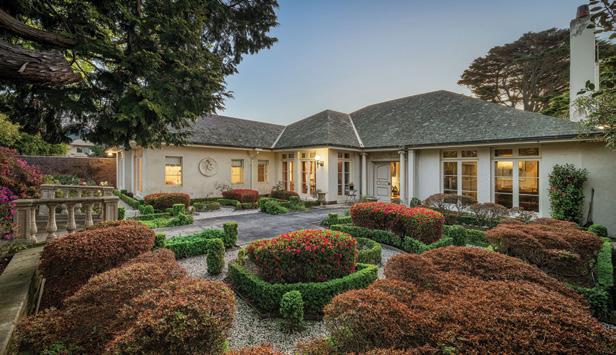
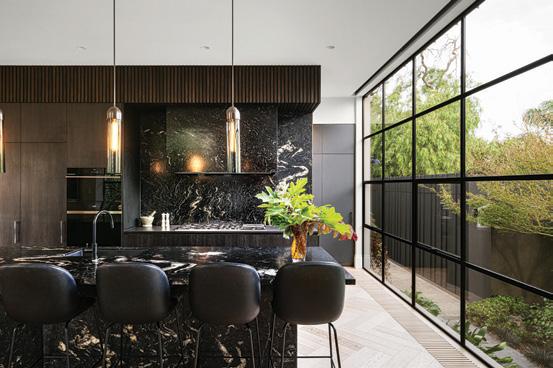
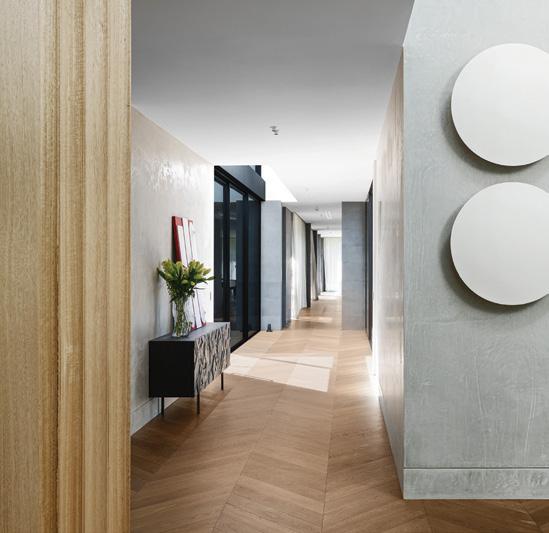

Breaking from tradition

Through meticulous craftsmanship and an intuitive understanding of the national sensibility, Christian Kimber is redefining Australian menswear from his Melbourne atelier—by Lucianne Tonti.
One of the first things to catch the eye upon stepping through the doors of Christian Kimber’s Little Collins Street boutique is what appears to be shelves of books—covered in the brown, green and burgundy hues of vintage encyclopedias. On closer inspection, they reveal themselves to be folders of fabric swatches from the many European mills Kimber collaborates with to produce his eponymous menswear label.
The emphasis placed on high quality natural fibres and their inherently plush, tactile textures gives Kimber’s award-winning tailoring a distinctly modern-Australian edge. At Christian Kimber, it’s clear the old rules of tailoring no longer apply. Where Melbourne’s corporate landscape once demanded a uniform of razor-sharp navy and charcoal
01 Versatile separates anchor the Christian Kimber aesthetic. Image: Gretl Watson-Blazewicz.
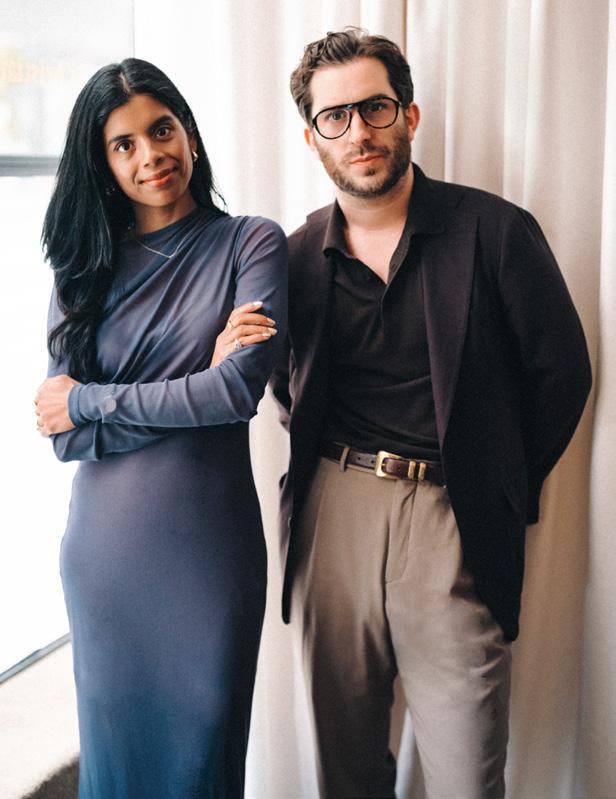
suits, Kimber has recognised a fundamental shift in how professional men want to dress.
The executives and entrepreneurs who frequent Kimber’s three Melbourne boutiques—his CBD flagship plus outposts in Armadale and Fitzroy—are not seeking a corporate uniform. Instead, they’re investing in thoughtfully designed separates that can seamlessly transition from dog-walk to airport to lunch meeting, all without requiring an iron’s intervention.
“The rules have changed,” Kimber explains. “Now you can choose how you want to dress—and how you want to feel.” He adds that most of his customers work in industries that just don’t demand traditional suiting anymore. “The contemporary workplace wardrobe has evolved,”
he says, adding that separates have become the cornerstone of professional dressing.
To emphasise the point, Kimber holds out a navy-blue blazer that is both unlined and unstructured. “We wanted to create a jacket for a CEO that feels like a sweater,” he says. “This is a wool-cashmere blend but it doesn’t really crease. You can wear it on a flight, then walk off the plane and straight into your meeting looking as polished as ever. It’s the ultimate work jacket.”
As traditional office culture and the strictures of a nine-to-five commute dissolve—with working from home more widespread and tech workplace culture bringing jeans, sneakers and hoodies into the boardroom—men’s tailoring is now able to define itself, liberated
from decades of rigid convention.
This newfound emphasis on lifestyle invites men to layer and curate a wardrobe of complementary individual pieces that align with their unique needs and values—as well as their tastes.
Always dapper, the British-born Kimber is wearing pale beige trousers with a single pleat at the front when we meet, a dark blue chambray shirt tucked in beneath a chocolate brown double-breasted blazer. The look is finished with brown loafers that match his brown leather belt. Although he’s aware that in Europe, the menswear runways from Giorgio Armani to Zegna and Saint Laurent have celebrated the renaissance of ’70s slouchy silhouettes, he describes the trousers he’s wearing—which have a straight, classic line—as rather wide for his typical customer.
This year, tailoring was front and centre at New York’s Met Gala too, but in contrast to the runways, the gala’s theme ‘Superfine: Tailoring Black Style’ inspired narrow fits and sharp lines. During awards season, Hollywood stars such as Adrien Brody, Timothée Chalamet and Colman Domingo embraced saturated colour, neckerchiefs and brooches to redefine the suit— reclaiming each look as their own. Reflecting on this, Kimber says, when it comes to tailoring, right now “anything goes.”
But at Christian Kimber, the clientele is not influenced by what’s being photographed at Paris Fashion Week or on red carpets. “We often have clients coming to see us, inspired by styling they’ve seen in a film or on TV like The Gentleman, for instance,” Kimber explains. “They’ll come in with a picture and say ‘I want this suit, or I want this jacket,’ and we’ll work together to reimagine it for their wardrobe.”
Such dreams are something Kimber is primed to fulfil. Beyond his ready-to-wear collection, he offers a made-to-measure service encompassing suits, blazers, shoes, leather outerwear, shirting and overcoats. Appointments are held in store and begin with a personal consultation before fabrics are selected and measurements taken. These specifications are then shared with specialist manufacturers in Portugal and Italy, and final fittings
02 Melbourne menswear designer Christian Kimber with his wife and business co-founder Renuka.
and adjustments are made locally once garments return. A recent foray into womenswear offers tailored pieces that seamlessly integrate with the menswear range.
While this kind of service has been a hallmark of tailoring for centuries—most notably on Savile Row, where Kimber worked before moving to Melbourne in his early twenties—the renewed popularity of his approach reflects something bigger. Amidst the churn-and-burn of next-day delivery and the omnipresent mass-produced fast fashion brands taking over malls and strips from London to Tokyo, a desire for a slower, more deliberate shopping experience has emerged.
“Our creative and technical possibilities are really unlimited,” Kimber says, mentioning his team of master tailors who work in the flagship store. He recalls recently recreating a double-breasted,
flared-trouser suit that one client had spotted in a film. “It was an incredible look,” he says, adding that the challenge comes when the vision pushes beyond the brand’s established aesthetic. Such projects, he explains, require considerably more time and consideration—it still needs to be an expression of the Christian Kimber house, and the client’s personal sense of style.
This focus on reading the customer and meeting their needs might be the secret underpinning the brand’s success. “I always work to get the fit right,” he explains. “If we can ensure someone feels great in our clothes and they’re cut perfectly for their body shape, then they’re going to come back.”
He acknowledges his job as a designer is also about understanding the lifestyle of Australian men—who might have to grapple with the cold of an early-morning Melbourne winter
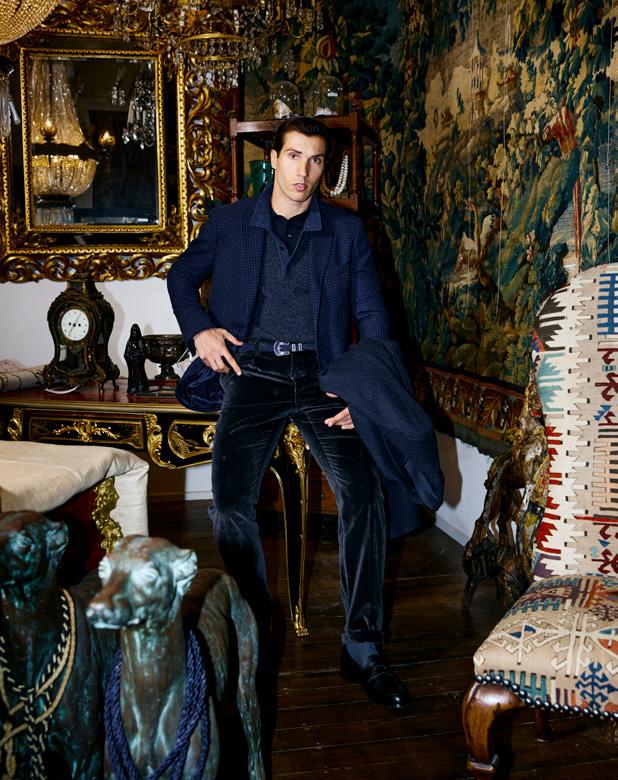
and Sydney’s high humidity in the space of a single working day.
“It is challenging when you think about Brisbane, for instance,” he says, holding up another unstructured blazer. “We do a jacket like this one for warmer climates. You can see the light coming through the fabric because it’s really that light and breathable.”
The stores—where you’re just as likely to be served by Kimber as his wife and co-founder, Renuka—have become community touchstones; a place outside the rhythms of busy executive life.
Designed by Brahman Perera, interiors at the warmly lit flagship store reflect this balancing act between traditional service and modern expectations. On one wall, a film of the Tasmanian outback shot by cinematographer Alexander Naughton plays on a large screen. Echoing the Australian landscape, the space’s earthy palette captures the essence of the man Kimber serves: masculine and refined, but refreshingly unpretentious—a fine fit for the national character that he so deftly channels.
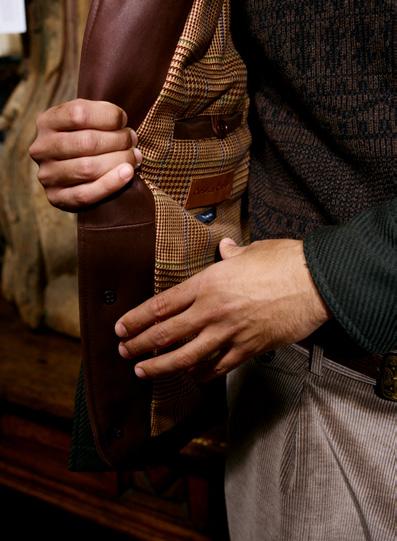
03 With rigid office dressing rules no longer relevant, Kimber’s approach pairs contrasting fabrics and casual elements. Image: Gretl Watson-Blazewicz.
04 A dedication to craftsmanship is revealed in every detail. Image: Gretl Watson-Blazewicz.
THE MAKING
RENAISSANCE
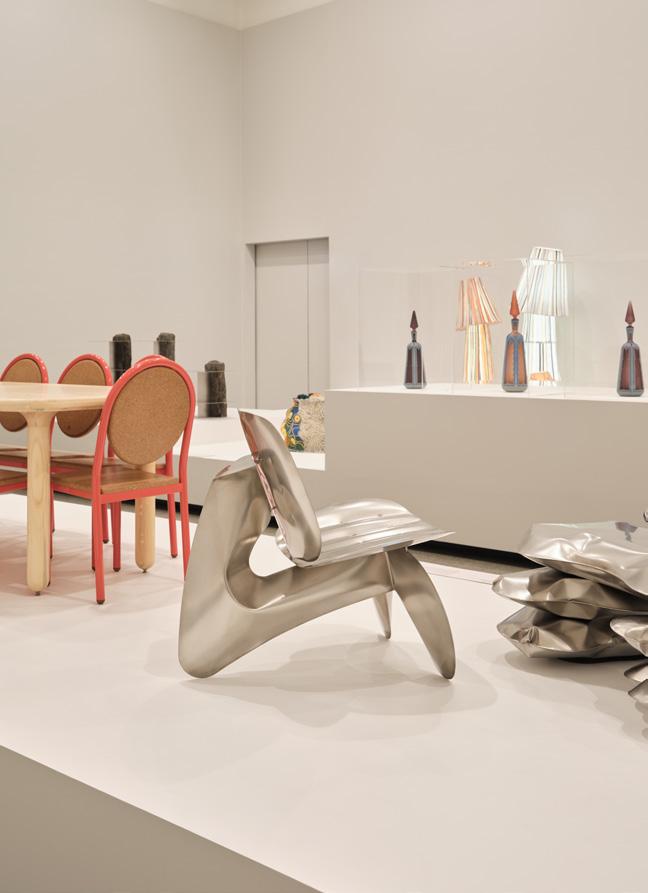
In a world racing toward automation, the art of making by hand has never felt more vital. The 2025 Rigg Design Prize is championing the next generation of talent keeping traditional craftsmanship alive—by Amelia Barnes.
Australia has no shortage of design awards, but the Rigg Design Prize—presented triennially by the National Gallery of Victoria (NGV) since 1994—stands apart as the nation’s foremost contemporary design award from a public cultural institution. Now the oldest national design prize run by a state gallery, the invitational program has elevated hundreds of designers over three decades, including 2009 winner Simone LeAmon, curator of contemporary design and architecture at NGV, who has overseen the award since 2015.
LeAmon believes the Rigg Design Prize is especially pertinent in the current landscape, where creatives are contending with escalating economic pressures and the disruptive rise of artificial intelligence. The exhibition’s 2025 theme, Next in Design, stands almost in defiance—spotlighting early career practitioners under the age of 35 who are
mastering human craftsmanship across ceramics, glass, furniture, lighting, jewellery and object design.
Adelaide-based Aranda artist Alfred Lowe was named this year’s winner of the $40,000 prize, with his ambitious ceramic vessels You and me, us never part (2025) unanimously selected by the jury. The work comprises two large-scale figurative ceramics combining rigid clay with soft raffia adornments, exploring themes of beauty, community and Country through contrasting materials. The prize was adjudicated by a jury of leading industry experts and past winners, who praised Lowe’s work for its “ambitious scale and emotional resonance.”
Now more than ever, LeAmon says, emerging creatives are reliant on industry support. “In the history of the Rigg, this is unique,” she says of the approach to this year’s selection.
Rather than focusing on established and mid-career designers, as it has traditionally done, “We’ve flipped it to look at practitioners within the first decade of their career,” she explains. The result is a compelling survey of raw talent and unbridled ambition— and a vital launchpad for Australia’s next generation of makers.
Each edition of the Rigg Design Prize explores different creative territories, from focused examinations of textiles and seating to broader investigations of spatial design and visual communication. Its tenth outing sees a return to the program’s roots in honour of its benefactor, Colin G. Rigg (1895-1982), who was deeply passionate about decorative arts and craft disciplines, and helped acquire works for the NGV as secretary of The Felton Bequests’ committee.
Next in Design continues Rigg’s legacy, while celebrating makers committed to material practice.
“At a time when conversations around digital and AI are all-pervasive, this [approach] provides us an opportunity to reflect and encounter work that is produced through incredible, deep, tacit knowledge which is gained through working with material,” LeAmon explains.
Despite their diverse practices and origins, this year’s finalists share a common thread: an experimental curiosity toward traditional materials and methods, filtering centuries of craft knowledge through a contemporary sensibility. “We’re looking at work that could only be made in the 21st century,” says LeAmon. “These practitioners are reflecting on everything that’s been designed and made in the past, and they’re choosing what to place emphasis on.”
2025 —
ALFRED LOWE WINNER
South Australia
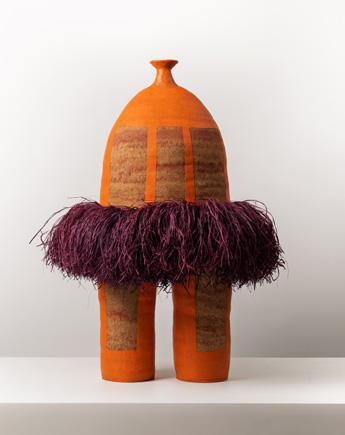
Working from APY Studio in Adelaide, Arrernte artist Alfred Lowe creates distinctive large-scale ceramics— typically around 1.5m tall—adorned with woven raffia pieces. His clay of choice is coarse-textured Buff Raku Trachyte, which imparts small cracks and rough edges reminiscent of the natural rock formations where he grew up in Central Australia. “These beautiful mountains stand strong and comfortable in their own skin,” Lowe explains. “Much of [their] beauty comes from erosion and scars, and this is a theme I explore a lot in my work: perfection in imperfection.” His winning Rigg commission took around three months to create, including nine days of building and decorating, and up to three days of weaving.
The resulting works demand attention with their vibrant colour and sheer scale. “I want my work to draw in the oxygen around it and be noticed. I want it to be bold and brave,” he says—an unapologetic vision that speaks to a spirit of experimentation and fearless authenticity.
DOUGLAS POWELL (DUZI OBJECTS)
Western Australia
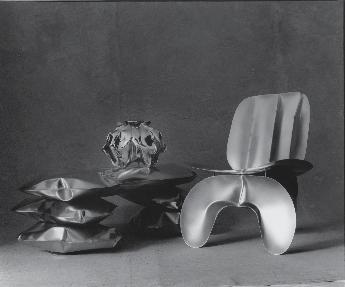
Duzi Objects is the furniture and object studio of Douglas Powell, who grew up in Zimbabwe and trained in the UK, before moving to Perth, Western Australia, where he transforms industrial hydroforming into sculptural art. In Powell’s hands, the utilitarian process—typically used to inflate flat sheets under pressure for engineering purposes—is subverted to create one-of-a-kind vases, lamps, mirrors and armchairs from stainless steel, aluminium and brass.
“The greatest challenge is also the essence of the practice; allowing a process normally associated with industrial precision to find new life through loosened control,” Powell explains. “After all the preparation is done, the final act belongs to the material and the process.” Powell’s surrender to material unpredictability embodies the exhibition’s argument for the enduring relevance of the handmade.
The Rigg Design Prize 2025 is on display until 1 February 2026 at The Ian Potter Centre: NGV Australia, at Melbourne’s Federation
Duzi Objects, Mbosho table, Luva chair, Physalia vase, 2025. Image: Dylan Le’mon. Marlo Lyda, Kin lamps, 2025.
Rigg Design
2025, currently on display at The Ian Potter Centre: NGV Australia. Image: Madeleine Burke.
Square. Free entry.
ON THE RISE
MARCEL HOOGSTAD HAY
South Australia
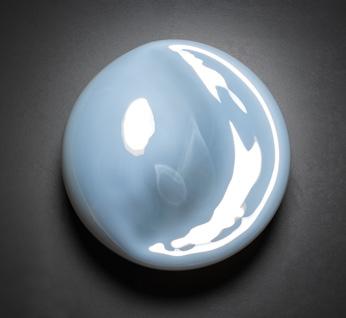
Marcel Hoogstad Hay creates blown glass sculptures that appear as metal through their mirrored surfaces, resulting in patterned reflections that inspire his broader practice. “I’m interested in the ways people perceive the world—our perceptions of space, time and matter—and how these notions relate to physics,” he explains. “When I’m designing my works, I’m thinking about both astronomical and quantum scales. I am in total awe of the sublime vastness of things happening at those scales.”
An artistic childhood encouraged Hoogstad Hay’s early interest in glass, cemented by his training at the acclaimed JamFactory in Adelaide and international residencies.
He now creates large-scale pieces using traditional Venetian techniques to introduce pattern and linework, finished with a silver solution. This fusion of ancient glassmaking methods with contemporary conceptual inquiry exemplifies how traditional craft can explore the most fundamental questions about our universe.
KOHL TYLER
Victoria

New Zealand-born Kohl Tyler spent seven years painting botanical subjects before transitioning to ceramics upon moving to Melbourne. Her sculptural vessels emerge from slab building, coiling and carving techniques, with bands of clay layered like geological strata to create deliberately weighted, undulating forms.
Tyler’s practice draws inspiration from flora, fossils, and skeletal structures, resulting in what she describes as “seemingly nebulous non-human lifeforms.” Her vessels are finished with matte white glaze and fired at temperatures up to 1280°C— a process that encourages dramatic movement during firing. The extreme heat creates cascading effects where glaze pools into shimmering white spills while exposing the buff stoneware clay beneath, revealing intricate carved textures. Tyler embraces this uncertainty, explaining: “My process intentionally pushes the material during the firing process, welcoming movement, dynamism, and yielding forms that speak to the natural.”
MARLO LYDA
New South Wales
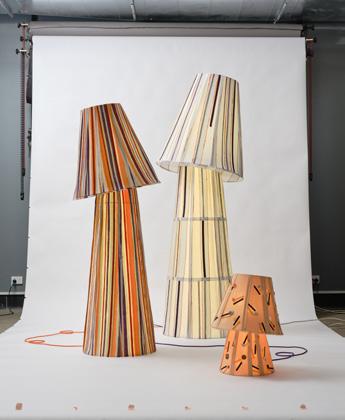
Working across furniture and lighting, Sydney maker-designer Marlo Lyda finds hidden beauty in discarded materials. Building on her work shown at Melbourne Design Week this year, Lyda has turned her attention to lighting for her Rigg Design Prize entry. Collectively titled Kin, her series of three lamps honours the women in her family, with each size representing different generations. The largest features re-dyed lace saved from Lyda’s late grandmother, a seamstress. The second incorporates velvet ribbon referencing her mother’s work as a costume designer, while the smallest represents Lyda herself, adorned with buttons reflecting her personal obsession. “This is the first time I’ve united my upbringing with the design practice that I’ve been cultivating,” she explains.
The shades and tiered metal bases are clad in deadstock cotton. Lyda first stripped the original pastel colours from the fabric, then re-dyed in hues of aubergine and burnt orange. The resulting trio’s softly tilted heads lend tender poise, as if paused in conversation. Intuitive and beautifully unresolved, each piece is tailored not to sameness, but to difference.
Marcel Hoogstad Hay, Celestial glass sculpture, 2025. Image: Pippy Mount.
Kohl Tyler, Esse II sculptural vessel, 2025. Image: Felix Adsett.
Alfred Lowe, You and Me, Us Never Part I, 2025. Image: heyandy.
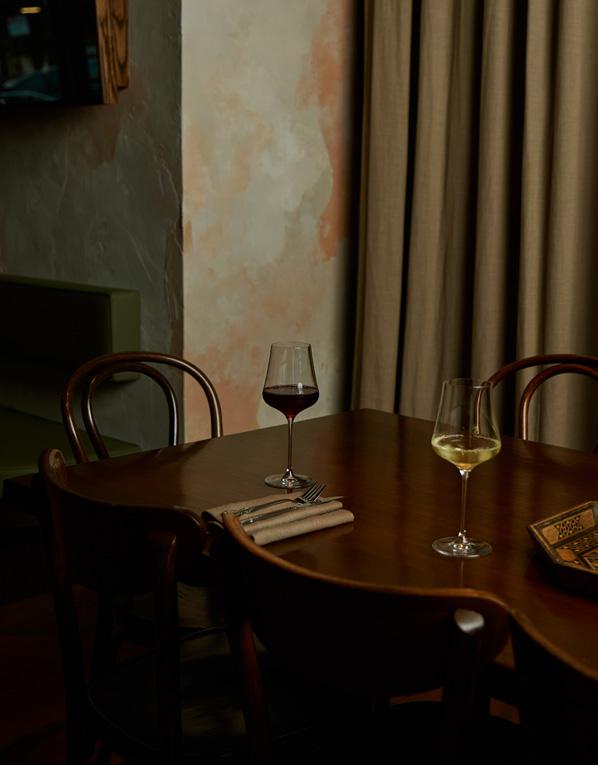
Sophisticated soul
Acclaimed chef Tom Sarafian’s muchanticipated debut venture isn’t just another restaurant opening—it’s a deeply personal journey through family history, culinary influence and cultural expression—by Tomas Telegramma.
Even while working at a restaurant as iconic as London’s St John, chef Tom Sarafian had his family’s food top of mind. “I’d be grilling lamb thinking ‘imagine how good some toum would be on this’,” he recalls, referring to the whipped garlic paste that is a staple of Levantine cooking.
A third-generation chef with Armenian and Egyptian heritage, Melbourne-born Sarafian certainly sharpened his butchery skills at the nose-to-tail pioneer, but what proved most defining were his years spent working under Greg Malouf, the globally influential Australian chef who passed away in 2024.
“Working with Greg early on set the tone of my entire career,” says Sarafian, whose mentorship under Malouf—spanning Melbourne’s MoMo and London’s then-Michelin-starred Petersham Nurseries—exposed him to refined European technique and fresh perspectives on tradition.
“I was seeing dishes from my childhood executed with a beautiful finesse I didn’t know was possible.”
What followed were extensive travels throughout the Middle East, guided by destinations explored in Malouf’s genre-defining cookbooks. Sarafian eventually returned to Melbourne, taking a head-chef role at Rumi, and later at the nowshuttered Bar Saracen. It was at the latter that his silky-smooth hummus earned cult status—enough to prompt him to launch his own condiment label, featuring elevated takes on toum and harissa.
Located in the increasingly residential northern end of Smith Street, Zareh is more than just a culmination of Sarafian’s professional experience; it’s a heartfelt tribute to his family’s culinary legacy.
Named after his late grandfather, Zareh Sarafian—an Armenian from Egypt who forged a career in Melbourne’s French fine dining scene during the 1970s and ’80s—the restaurant offers nostalgic nods to the family via thoughtful interior details and historic newspaper clippings celebrating the patriarch who started it all. “He set the scene for us,” says Sarafian of his grandfather. “He’s the reason that all we do revolves around food.”
Passion has turned into a profession for several of Sarafian’s family members, with Zareh now serving as the unofficial headquarters for the close-knit clan. His dad Haigo marinates the house olives, brother Nikki makes the dips, and cousin Bella works front of house. Meanwhile, partner Jinane Bou-Assi brings her marketing expertise to bear as an unstoppable force behind the scenes, even stepping in to welcome guests.
This sense of family unity gives Zareh its deeper meaning. “My grandma, she’s 93, was very proud to see us all working together,” Sarafian shares. And no doubt she is equally pleased to see the next generation enthusiastically celebrating their culture—a shared history expressed through food in a restaurant that feels like home.
While Zareh’s menu resists being pigeonholed into any one cuisine, Sarafian confidently traverses the Middle East and the Mediterranean, with a strong focus on Lebanon, thanks to Bou-Assi’s heritage. Several distinctive dishes trace back to

Armenia, whose cuisine remains largely unexplored in Australian dining. “The Armenians and the Arabs coming through [the restaurant] are so thrilled and proud to see dishes they know so well done in such an exciting way,” he says.
Smoky khorovats (Armenian barbecue) is a cornerstone, with meat grilled close to the coals for an unmistakable char and aroma. “There’s a rule that the meat should be no higher than 10 centimetres off the charcoal,” Sarafian explains. “It creates a kind of smoke tornado that swirls around, perfuming the meat.”
Another Armenian classic, ghapama, sees Sarafian hollow out an heirloom pumpkin, brushing its interior with butter and oak honey before filling it with spiced rice, toasted nuts and dried fruit, then roasting to tender perfection. He’s also curing his own bastourma (air-dried beef), which might arrive atop grilled sourdough with fresh goat’s curd and marinated bullhorn peppers. His signature hummus remains a fixture, crowned with Queensland prawns and sweet spanner crab.
“With our food being quite rustic and humble, we wanted the space to feel elegant,” says Sarafian of the interiors, designed by Min Chun Tseng. Inspired by his grandparents’ home, it’s already resonating with diners for its effortless charm. “The best compliment we’re getting is that it doesn’t feel like a new restaurant; that it feels lived-in, in the best way possible.”
That easy familiarity speaks to more than just good design—it reflects a soulful approach where the atmosphere is as carefully considered as the menu. Tucked beneath a midrise apartment building, the intimate 40-seater features dusty-pink limestone walls, olive-green banquette seating, and a wood fire-fuelled open kitchen. The bar, led by Matt Linklater (ex-Black Pearl), showcases inventive cocktails built around arak, including an ice-cold
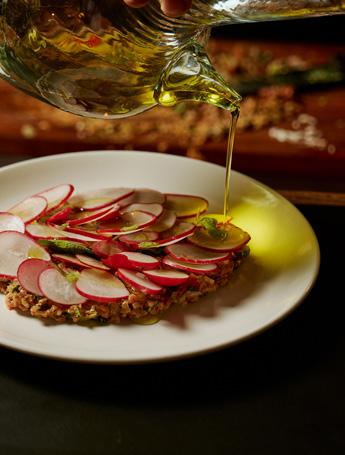
martini crowned with Sarafian’s twist on the classic Basque gilda. European, Middle Eastern and Australian wines also feature.
As much as Zareh is a self-assured debut from a young chef embracing his identity, it’s equally a tribute to the mentors and relationships that have shaped—and continue to shape— Sarafian’s journey.
“When it comes to places where Armenians can go to be together, there aren’t many in Melbourne,” he says, but it’s a gap Zareh is already bridging. “Last week, we had another [man named] Zareh come in. It turns out he knew my grandfather—they used to eat bastourma sandwiches and play cards together. Without the restaurant, that connection might never have happened.”
“He set the scene for us,” says Sarafian of his grandfather. “He’s the reason that all we do revolves around food.”
01 The restaurant’s warmly lit interior creates an intimate atmosphere. Image: Kristoffer Paulsen.
02 Zareh’s music and menu both reflect Tom Sarafian’s personal vision. Image: Kristoffer Paulsen.
03 Contemporary plating techniques add visual drama to traditional dishes. Image: Kristoffer Paulsen.

BY Alice Blackwood
WHERE SPIRIT TAKES FORM
INTERVIEW

Design anthropologist Trent Jansen infuses cultural meaning into his collectible pieces through a process of deep immersion, collaborative exchange and meditative materiality.
What does it mean to be a design anthropologist?
It’s a way of thinking that’s been developing for me over the past 20 years. I began using the term ‘design anthropology’ after encountering Jules Prown’s theories on material culture. He proposes that the things we make or design are the physical embodiment of our culture. I am now interested in finding a purposeful way of embodying cultural values in the things we design and make. I start by trying to understand what a cultural value set is, or the ideas that are important to a particular culture, through research and immersion. Through this process of storytelling and communication my collaborators and I often come across an important narrative or idea that captures a strong cultural value. We look to embody that within the things that we design together.
How has your Kurunpa Kunpu | Strong Spirit project allowed you to put this theory into practice?
This project came from time spent just outside Indulkana [a remote Aboriginal community in far northern South Australia, close to the Northern Territory border], with Indigenous Australian designers Tanya Singer and Errol Evans. Our project kicked off through ‘yarning’—a First Nations methodology rooted in Indigenous Australian knowledge systems. It’s a process
of sitting together and talking informally: getting to know one another, learning about each other’s families, communities, cultures, working practices—including the kind of materials and processes we use.
Through this process of yarning with Tanya, in particular, she spoke to me about the impacts of climate change on her Country. One deeply personal concern was how the increasingly dry conditions—less rain, hotter days—are impacting a significant flower, an important bush food in that region. Tanya captured this beautifully in a series of photographs, including one striking image of a little section of cracked earth. Through these images, she expressed a value system: the importance of Country, and the importance of the interconnectedness of all elements of Country—climate, weather patterns, plant life, the soil system, and so on.
It seemed to me that this was the clearest way to communicate the impact of climate change on that place. We instinctively turned to wood, beginning to carve its surface to recreate the faceted, cracked surface of the red earth in Tanya’s photographs. This was the starting point for our collaborative project—the cabinets and chairs that make up Kurunpa Kunpu | Strong Spirit [the collection born from a three-year intercultural design collaboration between Singer, Evans and Jansen, which appeared at Design Miami in 2024].
← Swamp Creature chair (2024), on display at Studio ALM.
→ Jansen’s hands-on approach reflects his commitment to traditional making processes and material understanding. Image: Romello Pereira.
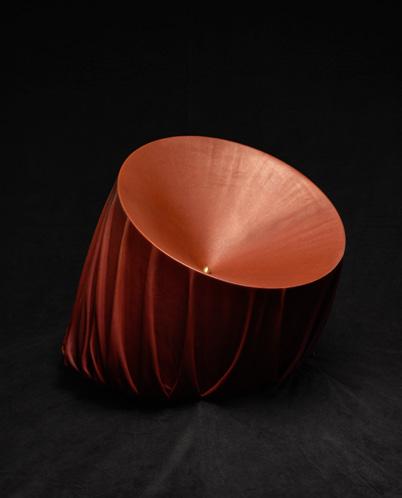

Your recent exhibition, Two Decades of Design Anthropology, at Useful Objects revealed the unique relationship between your work and the materials you use. Can you tell us about that?
I am inherently interested in natural materials that require minimal processing— things that you can take directly from the environment and use. With natural materials, there’s usually some kind of processing involved, but the less processing the better.
I’ve always worked with timber, leather, stone and, to some degree, metals. I’m interested in bringing form to materials in a new and innovative way. Like, using a material in a way that it wants to be used—which sounds insane— but letting it do what it wants to do. I love working with leather, for example, because you can only make it do so much; you can only stretch it around a compound curve so far, and then it just wants to fold and wrinkle, because it has this particular structural integrity. I like to work with the beautiful way that it folds, puckers and ripples.
Who would you name as your greatest influences?
My university lecturer Dr Vaughan Rees at UNSW Sydney taught me to think critically and strive for innovative, unique and good design which, hopefully one day, may even be great design. Soon after I graduated, I met David Clark (then editor-in-chief of Vogue Living) who is a good friend with an eye honed to the smallest details. Both Vaughan and David, always insistent on perfection, taught me that every detail must be considered and perfected, which is critical, especially in the collectible end of the market. My time spent with Dutch designer Marcel Wanders, who is an innovative, creative and hard working businessperson, taught me much about the attitude and grit you need to succeed in this industry.
What are you working on next?
At this very moment I’m working on chairs that use full cow hides. There is a frame to provide structure, but the leather flows off the frame, as though suspended in space. This new project is with my longtime collaborator, Nyikina man Johnny Nargoodah. Over the past 15 years, Johnny and I have developed a working process we call ‘sketch exchange’ where one collaborator creates a sketch—an idea they are interested in exploring—and then passes that sketch to the other collaborator. The second person refines the initial sketch and then employs their own ideas to send it in a new direction, then returns the revised sketch to the first person, who does the same. Through this process, Johnny and I have found that we can bring both of our skill sets and approaches into our design and idea development processes, ensuring the creative vision and design outcomes are shared.
Trent Jansen’s exhibition, Poiesis Symvoli: Poetic Objects Crafted Through Collaboration, is at Studio ALM, Potts Point NSW until 19 October.
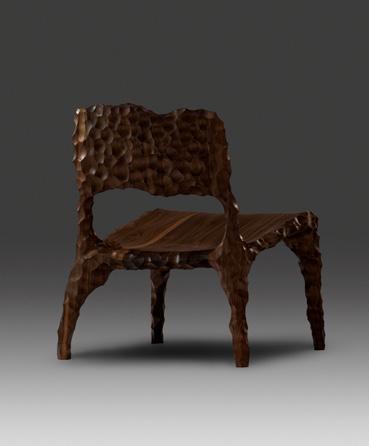
02
Saddle armchair, collaboration with Johnny Nargoodah (2020). Image: Romello Pereira.
03 Manta Pilti Credenza/Dry Sand, collaboration with Tanya Singer (2023). Image: Fiona Susanto.
04 Manta Pilti low chair in American walnut, collaboration with Tanya Singer (2023). Image: Fiona Susanto.

“I love working with leather... I like to work with the beautiful way that it folds, puckers and ripples.”

05 Pankalangu armchair, collaboration with Broached Commissions (2017).
Image: Dan Hocking.
06 Pankalangu Cabinet (detail, collaboration with Broached Commissions (2017).
Image: Tobias Titz.
OUT AND ABOUT


ORCHESTRA
A Brisbane mainstay has made its Melbourne debut at Collins Place, bringing acclaimed modern Australian dining across three levels. Victorian-born executive chef Jake Nicolson (ex-Lake House, The Ledbury) is showcasing premium dry-aged beef from leading producers nationwide, including Mayura Station Wagyu, wood-fired over ironbark on a Josper grill. Native ingredients elevate the menu, from Paroo kangaroo with pepperberry to wood-roasted rock lobster with warrigal greens. The moody interiors span a street-level cocktail bar through to an intimate split-level restaurant and private event space. 66 Flinders Ln, Melbourne CBD. blackbirdmelbourne.com.au

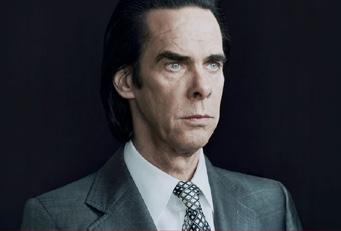
Vue de Monde executive chef Hugh Allen launches his first solo venture, with Yiaga (“seek and find” in Woi-wurrung language) transforming a once-derelict century-old pavilion within Melbourne’s historic Fitzroy Gardens into an intimate 38-seat dining destination. Designed by architect John Wardle highlighting Victorian materials, the brick exterior mimics the surrounding trees, celebrating the site’s natural setting, while interiors feature locally crafted furniture and tableware. Allen’s hyper-seasonal menu will showcase rare Australian ingredients, with dishes cooked over burning eucalyptus and wattle wood, promising diners a sense of discovery. Fitzroy Gardens, spring 2025. yiaga.au
ARIA Hall of Fame inductee Nick Cave brings his Wild God tour to Australia for his first shows with The Bad Seeds since 2017, performing at a series of outdoor locations. Fans of the alternative rock icon can expect a two-and-a-half-hour spectacle featuring songs from the band’s 18th studio album Wild God (which debuted at No. 2 on the ARIA chart in 2024) alongside a back catalogue spanning four decades. Following rapturous European reviews, the tour promises large-scale production while maintaining intimate connection, with three Melbourne dates crowning the summer season. Alexandra Gardens, 30 Jan–1 Feb 2026. nickcave.com
Asia’s oldest symphony orchestra returns to Australia after three decades, with music director Long Yu presenting Eastern and Western classical works. Founded in 1879 and led by the conductor The New York Times calls “the most powerful figure in China’s classical music scene,” the ensemble survived Mao’s Cultural Revolution, emerging to global acclaim. The program celebrates cultural dialogue through Elliot Leung’s Chinese Kitchen: A Feast of Flavours, alongside Qigang Chen’s Er Huang Piano Concerto, featuring soloist Serena Wang. Rachmaninov’s beloved Second Symphony completes the performance. Arts Centre Melbourne, Hamer Hall, 13 Mar 2026. artscentremelbourne.com.au
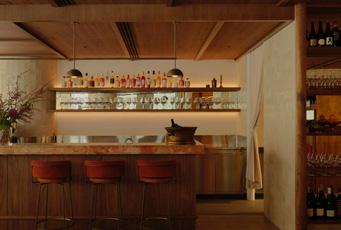
The team behind Melbourne establishments Tipo 00 and Osteria Ilaria ventures beyond Italian cuisine with Harriot, a modern European restaurant in the city’s legal district. Channelling France and Spain’s new-wave bistros, head chef James Kelly (ex-Embla, and the shuttered Michelin-starred Lyle’s in London) presents a weekly changing menu showcasing whole-animal butchery through dishes like pig’s-head terrine and lamb sweetbreads with finger lime. Sommelier Justin Howe oversees a 500-bottle cellar, pairing wines to the tasting menu, while the elegantly subdued fitout creates a welcome retreat from King Street’s corporate bustle. 555 Collins Street, Melbourne CBD. harriotmelbourne.com
Food & Drink
HARRIOT
Food & Drink
YIAGA
Performing Arts
NICK CAVE & THE BAD SEEDS: WILD GOD TOUR
Performing Arts SHANGHAI SYMPHONY
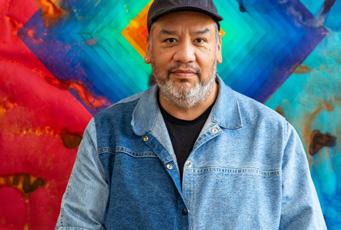


MacArthur Fellow Jeffrey Gibson made history as the first Native American artist to present a solo exhibition in the US Pavilion at the 2024 Venice Biennale. Gibson now joins Jeff Koons as an inaugural participant in the NGA’s new AFNGA: Visiting Creatives Program. A member of the Mississippi Band of Choctaw Indians and of Cherokee descent, Gibson’s interdisciplinary practice combines bold colour, complex patterns and text with found objects and sound, creating immersive experiences invoking communion and celebration. During his October residency, Gibson will present the gallery’s prestigious Annual Lecture. National Gallery of Australia, Oct 2025. nga.gov.au

One of today’s most in-demand figurative painters, Tschabalala Self presents her first Australian solo exhibition this spring at ACCA. The Harlem-born artist combines fabric, collage and painting with innovative printing techniques, creating exuberant characters that challenge perceptions of identity and embodiment. Working from her Hudson Valley studio, Self channels the Harlem Renaissance alongside jazz and dance into reflections on Black experience. Through new large-scale paintings, works on paper and a tri-channel video installation, Skin tight transforms ACCA, exploring emotional and spiritual dimensions while harnessing beauty as artistic resistance. ACCA, until 23 Nov. acca.melbourne
Closing GOMA’s 2025 program, this exclusive exhibition spans three decades of work by Icelandic-Danish artist Olafur Eliasson, one of the worlds most influential living artists. The multi-sensory journey features important early works alongside site-specific installations, many never before seen in Australia. Highlights include Beauty (1993), which suspends a rainbow in mist, Riverbed (2014), where visitors navigate a rocky landscape with running water, and The Cubic Structural Evolution Project (2004), where visitors perpetually rebuild a vast white LEGO city. Eliasson’s practice explores perception through installations that come alive through viewer interaction. GOMA, 6 Dec–12 Jul 2026. qagoma.qld.gov.au

After years honing his craft in top Melbourne restaurants and abroad, Mornington Peninsula native Nick McGonigal has returned to the region as executive chef at Lindenderry’s fine dining restaurant. Set within 34ha of gardens and vineyards, the 40room boutique hotel—recently relaunched by Lancemore—offers a contemporary Australian take on the traditional English estate. With credentials spanning London’s three-Michelin-starred The Ledbury under Brett Graham, plus Cecconi’s and Society in Melbourne and Sydney’s Bentley Restaurant and Bar, McGonigal focuses on hyper-local sourcing with Peninsula producers. 42 Arthurs Seat Rd, Red Hill. thediningroomredhill.com.au
Two titans of radical fashion design unite for the first time in NGV’s world-premiere summer blockbuster, pairing British punk pioneer Vivienne Westwood with Japanese avant-garde master Rei Kawakubo of Comme des Garçons. Despite different cultural backgrounds, both designers brought radical innovation to fashion, challenging conventions of taste, gender and beauty. Through more than 140 designs from the mid-1970s to the present, the exhibition explores convergences and divergences between these self-taught rebels. Highlights include Westwood’s iconic punk ensembles and the sculptural red petal dress worn by Rihanna at the Met Gala. NGV International, 7 Dec–19 Apr 2026. ngv.vic.gov.au
Visual Art
TSCHABALALA SELF: SKIN TIGHT
Culture
WESTWOOD X KAWAKUBO
Visual Art
JEFFREY GIBSON: VISITING CREATIVES PROGRAM
Visual Art
OLAFUR ELIASSON: PRESENCE
Food & Drink THE DINING ROOM

Luxury
Reserve this property with Kay & Burton Luxury Stays
Photography by Tom Blachford

Delivering
Stays
For owners
Kay & Burton Luxury Stays is your trusted partner in managing high-end short stays with discretion and care, tailored to suit your preferences. Whether you prefer a private, off-market arrangement for select occasions or broader exposure to our exclusive network for frequent opportunities, we offer a bespoke solution that aligns with your needs. We protect the integrity of your home while introducing it to an exclusive audience of discerning guests.
For guests
More than just a booking—Luxury Stays is a Kay & Burton experience. With deep expertise in the world of luxury, we offer elevated hospitality, tailored stays, and unrivalled local insight. Whether you’re escaping for a weekend, settling in for an extended retreat, travelling for business, or seeking luxury short-term accommodation, our handpicked homes provide comfort, elegance, and a touch of the extraordinary.

